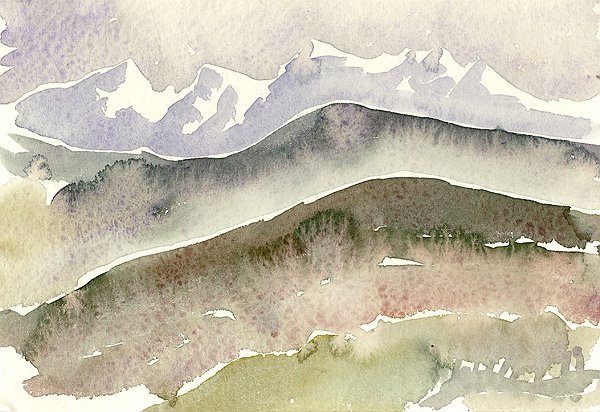
Chakra
For Ann, my travel companion in life
What will be the last trip we make – a breakup
towards the unknown or a trip home?
July 16th – September 16th 2011
People flooded past the three golden bodhisattvas that gazed over the Spiti Valley. Monks adorned in intensely deep ruby garments directed the dense columns of pilgrims around the temple where prayer wheels constantly rolled. A hundred yards away Ki Gompa struggled upwards the detached rock, its silhouette distinctly outlined by the early sun that just had crested the mountain ridge. The journey had reached its peak. I had embarked upon my own pilgrimage, both in inner and outer territories. In the company of monks I walked around the monastery in a meditative state enjoying the silent communion with the mountain, the people, the animals, the plants, the water and the wind.
A few weeks earlier at the Landvetter Airport in Gothenburg they advertised the beautiful summer country with images of ice-cream, strawberry lemonade och crispy biscuits. Am I leaving Sweden during one of its sweetest moments? It is all a dream; reality has more aspects to it.
Helsinki Airport played sweet Italian ballads in the coffee shop where I had a cup of coffee with a sandwich made of wholemeal bread. I was inside my own little sphere in the midst of the other spheres of elderly, young and middle aged people. We share the same world but there can be light years between the one and the other. Yet we are fundamentally the same.
Through a panoramic window I see a grey overcast sky and silvery grey runways, wet from the rain, where stiff white birds take off in straight orbits through the grey blue towards the sun. I am flying to India, the land I experienced in my past, an inside world now approaching from the outside. I travel from the imagined to the visible in order to update my sense of what is real. I am preparing myself for change. Slightly more than a year ago I returned from a trip to Sikkim, and now I am heading for other parts of the Buddhist Himalayas. Every trip to India starts off with a recapitulation my childhood India, a reunion with beloved places, the home I am carrying inside.
What we see is our experience
What we have no knowledge about we do not see.
16th of July
Indira Gandhi Airport in Delhi welcomed me with warm patterned carpet and I moved forward on enormously long running walkways to the arrival’s hall where I have a cup of tea with snacks at, for this country, an astronomical price. The fast newly built underground took me into the centre of Delhi. I faund a clean hotel with hostel fees. It was actually rather expensive for one night’s stay but in the long run it would turn a lot cheaper outside Delhi. I successfully reserved a train ticket to Dehradun for 20 bucks with food and drink included.
On the first day, the encounter with all memories from my Indian childhood is intense. It is as if the barrages of my memory are breaking down and everything starts rushing out all at once. The hotel is located near Paharganj in central Delhi. It is a microcosm where you’ll encounter all of India, both its attractive, alluring and appalling aspects. Parts of its structure seem ancient. Most of it is situated within the confines of a rectangular area surrounded by broad heavily trafficked streets that runs by the Old Delhi Railway Station. Its interior is a ghetto with narrow alleys packed with stores, hotels, restaurants, small scale handicraft, and street markets. Here you’ll find everything that is produced in India in terms of handiwork or souvenirs. Here are the traditions present that reach far back from the mystical Eastern Bazars where charlatans, con men, tramps and beggars spice up life accompanied by Ayurveda Yoga, Hare Krishna and hashish. This is the favourite arrival and departing site of Westerners. However, you won’t be able to stay very long in this challenging, noisy and dirty environment.
The cantinas lie next to each other right opposite the railway station. The fierce competition seems to be for life or death. Barkers try to drown each other with superlatives about their restaurant and tug at you while they show you a free table. Outside on the street the chef is working frantically at his pots. Even a small restaurant of twenty square metres has two barkers, one chef, two dishwashers, and two employees in the kitchen, three waiters, and the owner who collects the pay by the exit sitting cross-legged on a pedestal. There is a continuous flow of frenzied yelling and rattling with tin dishes in a place where anything china never would have survived. The food is warm and so powerfully spiced that all the other flavours vanish in my mouth, yet the Indians still munch on fresh chillies and have another round of the red gravy.
17th of July
From the morning train on my way to Dehradun I watched the landscape passing by. The flat agricultural land was interrupted by concrete houses, factories and brick distilleries. Houses washed with various lime colours was shining hypnotically in the morning sunlight. Factories that have given up their breath, steel skeletons in beautiful decline with gaping windows, a photographer’s Eldorado, all swiftly passing by. The brick distilleries showed up briefly with their oval parapets.
In the middle stands the massive chimney, apparently there only for the effect of being a chimney. Recently sun dried brick fill half of the trench forming air channels. In the other end there is a big wood furnace going and the hot air is effectively pulled through the brick mass and up through the chimney. At the same time the brick that was burnt earlier is moved out of the way and new layers of sun dried brick is put in place before the fire is turned. A stream of men and women carry the brick on their heads like ants on an anthill. Out in the fields people sit and beat the brick to dry in the sun. The Ganges plain has deep layers of clay providing an unlimited source for the brick distilleries. However, the forest has suffered considerably because of logging for burning fuel.
Dehradun, situated at the foot of the Himalayas, has a colonial legacy and a pleasant climate and is home to the State Parliament of Uttarakhand. The town suffers from growing pains and a life threatening chaotic traffic. Here you’ll find India’s best boarding schools, the Ministry of Forestry, research departments and universities. The Doon Valley is where the best Basmati rice is cultivated. This is also where the natural law activist Vandana Shiva is running a successful movement for the farmer’s rights to non-modified diversified seeds. A few miles to the east lie the holy Rishikesh and Haridwar with millions of pilgrims. The Beatles member George Harrison made a song in which the word “Dehradun” is repeated like a mantra.
Outside the railway station I happened to share a taxi with a French couple who were working at the Embassy of Delhi. They were on their way to a language class in Landour to learn Hindi. During the meandering car journey I told them about sites that are worth visiting in Mussoorie, spread about some mountain ridges two thousand metres of altitude and in Landour which is located some extra hundred metres further up. It is now the middle of the monsoon season and the water is gushing down the mountain side. I felt the smell of wet soil and the mist over the steep mountain. I experienced this every year as a child. Dressed in boots and a raincoat I walked soaked pathways through fern coated woods. When I returned home I had one or another leech painfully removed using salt on my calf where it had stuck, fat and black.
In Sister’s Bazar on top of Landour I found a room with a view towards the mountains through some tall Deodar (1). Clouds hide the snow-capped mountains in the distance, the hills are so green. Here in Landour I was born in 1952. At that time my mother worked at the Language School to which the French couple now were registering.
The people in the guesthouse are kind and accommodating. Sima is a smiling happy woman who makes my breakfast and supper.
The rain is lashing and brooks are formed everywhere, The fog has power over the mountain but the sight down the valley is clear.
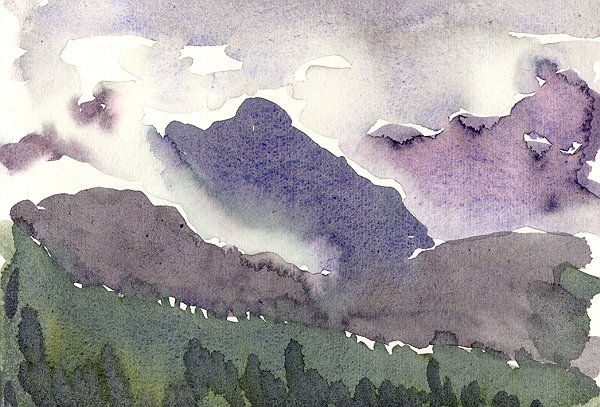
Communication with myself? Am I talking to my limbs, my heart or the bones in my body? All impressions come from the outside but are incorporated into my cells, synapses and nerves. I walk inside my thoughts, also monitoring this fact. Will I ever find the truth somewhere about the ‘I’, the ratios, the circumstances?
18th of July
Stomach problems, I did not feel well, slight nausea but couldn`t throw up. Excretions was thin and runny. My stomach must have got something it couldn’t handle already in Delhi the very first day. Carelessness brings about its own penalty. At last I threw up, a relief to have it done away with. Felt tired and exhausted.
19th of July
It was lovely to be well again. I relaxed. Payed a visit to the Mullinghar tailor and he recognised me. A year had passed since the last visit. He was sitting cross-legged on his soft elevated divan with a pair of enormous scissors that can cut the finest thread perfectly. The Singer sewing machine had been blessed with an electric motor and the ledger, thick as a statute book, was filled with fabric samples, measures and sketches. His Hindi always well articulated and easy to understand. To have a shirt or a suit tailored there would cost less than a ready-made one from the town boutiques; such is the unfathomable Indian economy.
I went to my favourite place in the bazar and ordered a samosa along with a cup of steaming hot and generously sweetened tea with milk.
I waited on the porch at the hotel formerly used as the Swedish School in Mussoorie. It started further up in Landour in 1947 and the students were largely children coming from missionary families, but the school moved to this building in the early fifties. It was terminated in 1967 since there were virtually no missionaries left because they were denied residence permit by the Indian Government. There was no other guests there save the Swedes, those that I have appointed to see, who should have been there. Ironically, they had made an excursion up to Landour where I stay. The old janitor greeted me and we began to chat. He makes heroic efforts to keep the place going. Thirty-five years ago he planted Cedar trees in the slopes of the garden and they have now grown to a small forest. He was also very proud of a few Deodar planted below the fence towards the bus station. Unfortunately, some of them died last year from the drought.
The fog was compact and the rain poured down. Along the mountain wall I played in the rapids when I was a child. I formed barrages and created waterfalls. The rain period was a magical time.
The fence surrounding the terrace that functioned as schoolyard had been renovated. The old cast iron ornaments had been welded into new frames. The old gate with the grid door was gone.
The electrical installations inside the porch looked like they did fifty years ago. Som connectors worked, others did not. They had installed three phase and an electronic meter in the vestibule. Apart from that, everything was like it used to be, the feeling was there, everything was preserved, windows, tiles, ceiling stucco ornamental work, doors and handles. No ugly additional constructions or renovations except modern bathrooms and lavatories. During my school years we had a indoor loo with pots that was emptied and cleaned every day by a latrine worker. Water was poured into enamel hand basins from a stone jar. We took showers in the backyard house using a bucket of hot water.
The greenery at the downhill walk was lush with bourgeoning red and yellow Dahlia. More flowers will come after the rain period. Honks from the bus station blended with heated yelling came through the milk white mist.
The ceiling of the porch featured an intricate pattern that was formed into geometrical shapes. As a child I used to follow the labyrinthine paths, a typical Islamic decorative element that can be found far away inside the Moorish palaces in southern Spain.
The house has features from old British castles and the Indian bungalow with a veranda. It is a palace completely symmetrical with intricate chiseling in the ceiling stucco. Flowery tiles laid from the floor up to above waist level run around the room walls.
I saw Roland and Ingvar at the bus station when I had given up on them and was on my way home. They belong to the older generation from the Swedish School era and were classmates to my elder sisters. It was a merry rendezvous sitting on the porch recapitulating old memories until darkness fell. We went down to Roland’s favourite place in the bazaar to enjoy somosas, golab janum and tea. During the bazaar stroll we looked for the recognizable and commented on the changes. In Kulri bazar the barbershop and grocery store at the steep uphill looked like that for at least fifty years without any noticeable alterations. I recall that a haircut 1960 cost 1.50 Rupees, which was equivalent to the same amount in the Swedish currency at that time. At my visit 1980 the barber recognized me and invited me for a cup of tea, now he was no longer there.
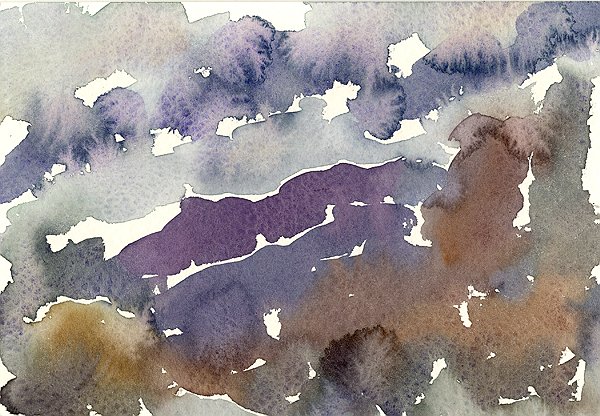
20th of July
The mountains are shrouded in clouds. I walked through the mist to Mussoorie. Houses, trees and people fade away in the distance as I arrive along The Mall. Everything assumes a mystical shimmer as if I would constantly find myself being inside a floating city high up in the clouds.
21th of July
The rain is pouring down, the monsoon is displaying its full potential. Memories chase and play with my impressions, plants, people, houses, and the rippling of water. Baby monkeys play near the garbage bins, dancing like feathers on the flat rooftops, chasing one another against the precipices they avoid with abrupt turns, easy as a child’s play. Moisture from the moss is typical of the rain season; everything is painted green from a thin layer of moss that covers walls, stairs, poles, fences and roofs.
I take a rewinding rest without any compulsions, without determination to meet objectives. What are objectives or fulfilment? Soon enough I will be no one anyway; everything will lose its content. Memories survive inside others. Here are experiences, proximity and being. We plan too much, worry too much. I don’t have to become something. Here it is so quiet, calm and still. Just myself and my thoughts, the disturbing thoughts, the thoughts that need to come to rest even within me. It is all, cosmos and awareness. The rhythmical sound from a dripping faucet somewhere creates a pulse that is difficult to shut out once it has been noticed. Human life only perpetuates, children cry and weep and need love and nourishment, stimulation and encouragement. Are they present here in the silence? They are present in consciousness, in the ever present vision of conscience, in the perpetual guilt we are carrying.
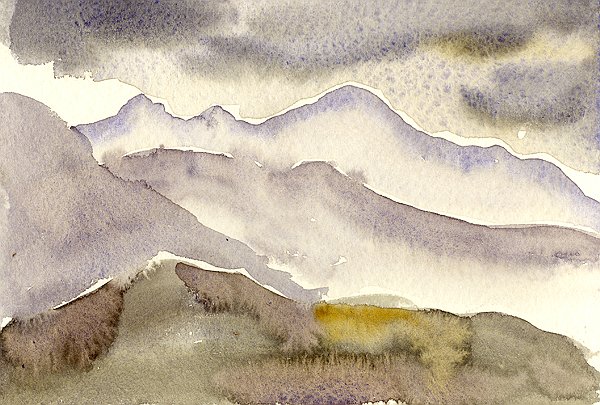
22th of July
It is a clear morning. From the window I can see all the way to the villages in the valley with cultivated teracces framed by greenery from the moonsoon. The mountain peaks are left among the clouds, the sun is shining through and gives the slopes an intense light green shade.)
My breakfast consists of paranta (filled fried bread) and tea. Perhaps it´s possible for a morning walk without rain. I usually walk round the mountain, one of three “chakkars” (2) that have been laid around the mountain peaks of Landour. A grey monkey, a Langur (Colobinae) is sitting in the deodar right in front of my window. Its tail is hanging low among the tree branches. He is watching the valley through the nearest trees with a composed grip around one branch calmly contemplating what there is to be done.
Weird dreams appeared last night. Everybody was there, both old friends and new acquaintances. I am fearful of confronting some of them in the dream. I manage to get away. It’s about an invitation to a big party. Everyone was invited, I could see that. There is a sense of fellowship among them, but I would refrain from participating for fear of what would happen. I can feel the alienation. I rationalise this by maintaining that it all will end in drunkenness and fighting anyway. I would just stand there in a corner, uncomprehending, unable to participate, unable to recognise what they talk about. Was this my experience as a fifteen year old when I migrated to Sweden, a land of dreams that became a brutish reality.
The day turns into night, green moss covering the rocks, the light green from the ferns on the trunks shine against the backlight at sunset. The sight is clear towards the horizon where the outline of mountains against mountains fade away into the distance. A virtual jungle is raised between the trees every year. Cicadas tune up first at dusk, replying each other with a deafening crescendo until they become silent in the darkness when the sun has set. The birds are heard for a while longer, a bat is flapping by. The abodes of humans in the mountains start to light up. Headlights of vehicles move like slow fireflies against the black. The stars in space are visible between the clouds, soon the sky will be completely clear. A shooting star appears every minute. Aircraft and satellites wander over the dome like tiny dots of light. Cosmos, we exist in cosmos. That should always be our viewpoint.
Down in Dehradun the town’s lights form a starry sky shimmering in a multitude of colours. If each light would represent a number of human beings, then what would the glimmering of lights in the heavens represent? They are so many more. There is an abundance of life we never will come into contact with. We dream about reaching beyond the Earth outside of the solar system but space is so inhospitable. We would need to build ships as large as planets that would contain whole eco systems sustaining millions of people during a journey that in human terms would last an eternity, but which in cosmological time would be like the life of a shooting star. However, if we save our planet here, maintaining balance and keeping our birth-rates down we don’t need to search for other Earths. Then growth rates must be held in check, exploitation maintained at a low and renewable level. Our scientific studies will remain scientific at a distance. But man is imbalanced, expansive, and hungry for new experience. Can’t keep peace with himself. A war may start for space and its resources. Perhaps extra-terrestrial life would weld humanity together. Here we are – one species, one Earth, one humanity. We care for our own, we make society a reality. Conflicts and unrest start like a fight between siblings. We protect the Earth. The dream of a better society is still present there and here within me. There is belief in development, however so different in different eyes. Development is a failure as long as there still are children that starve, diseases that kill although they’re curable, and terror and human envy. Man’s disturbing relation to himself and his environment. He seems to never grow up. In the tranquil clear night the uneasy heart continues to beat. Our own history and humanity have brought much rubble and shortcomings mixed with personal desires. That must be stilled, become totally still. Then comes the overview, the ocean, eternity, and we die like a fen-fire in the darkness.
23th of July
We live in the exciting openness toward history and creation, the new and fresh, unexpected things might happen. Memory is recollection of things long since dead that are good only for bringing life into the now, to fellowship, explaining emotions and explaining causality. I feel awake, I can smell and see.
Even the poor, tough and sturdy Doodhwala, the milkmen here at the Chardukan (3) square, use mobile phones. They walk mile after mile every day. Their phones must be a great asset to them when they work far away in the villages. I remember how they carried their pitchers made of tin tied together using a grid of rope. My mother checked the fat content with a graded floater. She always complained that it had been diluted, that it yielded too little cream.
I am trying various colours and shapes using the water colour box. The fog is dense from all morning to late afternoon. The rain is pouring down.
24th of July
My annual leave wages will replenish my travel wallet tomorrow. One week in Mussoorie has been soaked by rain water. Chilly air has arrived during the recent days of persisting fog, haze and continuous dripping. Communication over internet does not work very well. Has there come moisture into the cables and connectors? How do computers cope with air humidity?
There isn’t a lot to do other than gazing out over the milky valley, drawing a bit, painting a bit, reading and writing. Waiting in a humid reality with dripping from above, the birds are chirping, the fog is dense like a white wall behind the trees. The windows are foggy from moisture, a tangible proof of cold air outside.
I exercise my back; I eat food from my own supply and have a cup of tea at Devdar’s Guesthouse. The devdar in the garden, the “divine tree”, is dressed in moss and fern. How did this tree develop so many branches when deodars at most only have one straight trunk? I hear voices from inside the house, the twitter from the birds from outside; human voices are noisy.
There are children inside of me that cry. Are they a part of me, my own grief, my devastated life? Did not our life become the way we wanted it to be? My question is an existential one.
26th of July
Long wait at the bus station in Dehradun before the journey to Manali. Many Westerners are heading there. I could have been leaving yesterday but I didn’t feel well and felt even worse during the night at the hotel. It’s stomach problems. I had very little to eat in order to prevent me from throwing up during the bus ride.
27th of July
A challenging bus trip to Manali with squeaking brakes on the way through an untold number of by-ways before darkness fell. After a longer break in Chandighar late in the night the road became extraordinary pleasant, the speed increased and the constant stops to pick up new travellers ceased. The night was long and I still had stomach problems.

Manali
28th of July
The rain season here is almost as intense as it is in Mussoorie. Manali has grown since I last visited in 1987.Outside the old Manali a jungle of houses and small hotels have stretched out in disarray. Even the landscape has been damaged, and the orchards are being punched at the edges. I found a hotel with a view towards the mountains on the other side of the valley. The small cottage where I stayed in 1987 is a place I gladly would have returned to; I don’t know whether it’s still there. Resting for a while after the trip, and then I’m out for a sight-seeing in the neighbourhood. Maybe I could revisit my former cottage.
A tasty vegetarian momo at a Tibetan restaurant suits my stomach well. I often go here, for their momo is delicious. Old Manali has become an Eldorado with flourishing souvenir shops, trekking guides and hippie cafés. In Rishikesh the Westerner will encounter the mystical India. In Manali Westerners will come across the local folk, immigrated Tibetans, and magnificent natural scenery. Nature is the destination, not the mystical. As a common denominator there is ganja, cannabis, growing freely in nature, the hashish that has attracted tourists since the seventies. From here people move on to Goa during the winter season.
I hear the roar from the rapids behind all newly built hotels along the village road. It is more difficult to gain access to the cataract now, compared to 1987. Everything was so much more pristine back then. Now motorised vehicles are roaring by and tourists move forth in hordes.
Why did it take twenty-four years for me before I made my first attempt to reach Lahaul and Spiti? Leh is the grand destination here with its lines of vans and jeeps departing every day. Zanskar is also located there beckoning like a mythical landscape between Lahul and Leh. There is going to be many more trips in the future. Lonely journeys? I have never felt lonely when I am travelling in India; loneliness is always something that will catch me when I return to Sweden.
I walked uphill towards the old Manali which is a jumble of houses with footpaths in between them. There was no proper village street in those days; however some paths have been made broader and paved to work passably for car traffic. Re-encountered the original old stone houses that have animal stables at the ground floor and all wooden exterior corridors upstairs. The corridor extending from the building and running all the way around the house was used as a depository for animal fodder and can be covered with panes to enhance its insulation capability. The animals down there will keep the living quarters above warm. The rooftop is made of flat large rocks that are slanted in various directions to provide an effective shelter against the rain. And in the exterior corridor glass windows facing the south can gather heat from the sunlight during the winter. Everyone had some cows, sheep and goats. This year’s calf having lovely large lively eyes stood tethered under the exterior corridor that protected it from the rain. There stood also the loom used to make hand-woven wool for shawls, sweaters, caps and mittens. The local produce was traded in a cooperative store in the middle of the village.

When I turned my gaze towards the valley I saw the house I lived in 1987 still standing there behind all the trees. I sat down and spoke with an elderly man who herded a cow and one sheep. He knew the house that I once lived in and directed me as to how to get there. He complained about all the hotels that had devastated the farming land for the villagers. Some of them depended on the extra income but many hotels were funded by rich Indians from the plains.
Apple orchards, sheep husbandry and weaving mills had become less important. Tourism had taken over with internet cafés, souvenir shops, trekking guides and hippy restaurants that played Bob Marley. The cottage where I lived had been modernised with electricity, running water and a small outhouse with a lavatory. Everything looked idle for the moment and the owner was nowhere in sight. Perhaps this is one of the places that are permanently let to Western tourists. From here I would be able to get back “the Rock Way”, as I could read from a sign, which was a narrow trail between the roaring rapids that I have walked so many times before.
The basis for the tourist business is the guided mountain walks. Ganja, or marijuana, from the cannabis that grows naturally in the slopes is a source of big income. Tibet, Tibetan Buddhism, nature, the flora and the fauna are alluring factors to many people. The locals do not seem to be able to handle this boom. Everything is coming up in a wild and uncontrollable manner. Ugly architecture and bad construction of new houses are going to take them down after a number of years because of rain, cold weather and sunlight.
29th of July
A morning for encountering one’s own pallid self with languid eyes from sleep, that body in front of you that is your outward persona. Imaginary conversation partners, resolutions from the inner voice and external pressure.
The world is beautiful, life is beautiful. The fact that we wear clothes shows that there is something we lack; that we are not happy with our body and anxious about what it might disclose. But our unveiled face will nonetheless betray it all.
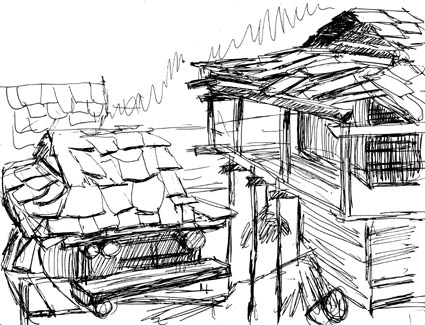
Those noble old houses; their foundation wall is made of layers of stone and beams. The wood provides cohesion while the stones bring weight. There are still people around who can build such houses but the timber required is very expensive. Those beams are hundreds of years old and effectively protected by a tight overarching stone roof that has good ventilation. They were gathered from hard slowly growing cedar trees found at high altitudes in the mountains. This wood is resistant and will not be infested with insects or rot. But lumbering has been prohibited by the government and therefore no one builds in the traditional way anymore, and shipping wood from remote areas is going to be too expensive. There, in between the old wooden houses, rise abodes made of concrete with a tin roof. Would it be possible to mimic the architecture of old using a stone roof upheld by a wooden truss and walls of reinforced concrete all resting upon a stone fundament? A project like that should have been launched to preserve the old Manali, but now it seems to be too late for that. Many houses have already collapsed and are being raided for wood logs.
I am sitting on top of the hill in the middle of the village conversing with a house owner who is herding his cow. Everybody seems to have a cow which also has calves. I talk about how I grew up in India, about the Christian mission work my parents did, about my travelling, and about my stay in Manali twenty-four years ago. The gentleman is touched by the various aiding work that the missionaries performed. Perhaps that is a valuable thing that Westerners could be accounted for, unless that was a calculated effort.
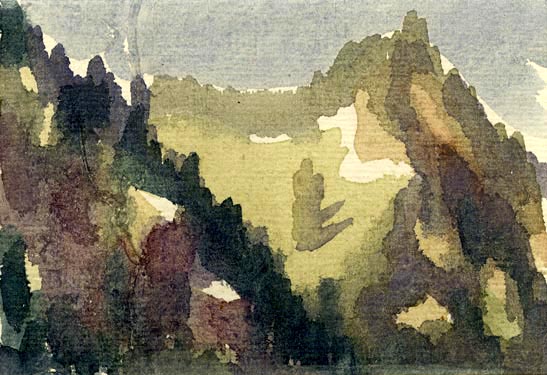
Started drawing the houses. Two little girls stand behind me looking, giggling. They give up after a while.
I walked far beyond the apple orchards up into the mountains until the forest became dense from hefty voluminous deodars reaching towards the sky, a mighty and rare one having many bifurcations in its trunk. The roar from the rapids deep down could be heard clearly and the cicadas commenced to play in the twilight.
Three dogs that yelled at me start to accompany me on my way down to the community; three well cared for and well-nourished dogs.
I see a gang driving ‘new’ old Enfield 350 cc motorcycles made in India. They are loaded with tents, sleeping bags, sleeping pads and surplus petrol cans on both sides of the rear wheel. Beyond the Baralacha pass on the way to Leh you won’t find any petrol stations. Modern hippies with plenty of money, style, dress code, and faith in life are chasing the adventure, like in Easy Rider, in the same romantic vein. There were many different kinds of them, like the heavy metal sort with leather, rivets, fat belly, beard and a moustache. There was the New Age hippie, holy treads around the neck, bracelets, head bands, and scantily clad young women in the back seat, in case they didn’t drive a motorcycle themselves. All of them gathered in this particular rock café down the village road where the fumes of hashish began to billow. I daydreamed on what life would be like for such a group. Is there inside everybody a wish to master the expanses independent of guided tours and itineraries?
I carry the history I have for good or evil, I have the skills that I have acquired with all its shortcomings and deficiencies.
After rain come sunshine, night falls, morning comes with clouds heavy with rain. As the day proceeds the sun shines hot from above burning my neck as a blowtorch. The clouds hide the sun, the cold returns and night falls again. Rain is coming, dripping on the stone pavement, the sound of the rapids in the distance, thunder flashing on the far side of the mountains lighting up the clouds.
I go into a tranquil state, immersed by what is, calm, attentive and aware, forgetting all the troubles. Feel tired despite the night’s rest. I had weird dreams due to a slight cold. Felt more alert later on and managed to get some cash from the ATM down in the village. Now I am well-off before any eventualities that may arise in the middle of nowhere beyond the high passes. Bought bananas, papayas, a memory card for the camera and postcards to send home. Relaxed with a cup of coffee inside some sort of a backpackers retreat where one could buy wholemeal bread, read newspapers and exchange old books that you had read and get other books in return that were sitting on a bookshelf.
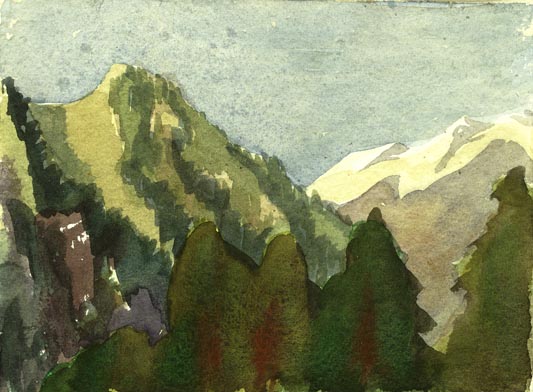
I took an evening uphill walk along the rapids to a place with a view towards the innermost mountains with a dense forest beside the ravine where the water gushed forth. A quiet chat at a coffee shop in the midst of the roaring rapids while darkness fell over the surrounding neighbourhood.
How vast is not our world? Why are we dividing it? Why do we divide the world into mine and yours?
30th July
Using the local bus service I took a day’s trip to Naggar a few miles down south where a museum has been established in the home of the Russian artist Nicholas Roerich. He happened to spend half of his life in the Himalayas painting nature, studying the people and the culture. As a thinker and philosopher he reached a conclusion about the peace-keeping nature of culture and founded a community for the preservation of culture during a state of war, the so called “Roerich Pact”. That was followed by an international convention signed in den Haag 1954 by a large number of nations. He also founded the Urusvati “Morning Star” institute in 1928, a kind of early New Age movement with cross-disciplinary studies in astronomy, anthropology and culture for the proliferation of peace and agreement. The light of the air, and the cosmic radiation were seen as an advantage in this part of the world. Located at the highest point of them all was the museum of Folk Art built upon a plateau that is surrounded by tall deodars.
A pleasant cool breeze is blowing through the trees where I sit in their shade. Dry conifer needles fall down on my shoulders and knees as the wind is hissing between the branches, and in the background I can hear the rapids. A black butterfly flutters by, birds twitter energetically in the bushes. The Kullu Valley is stretching out behind the tree trunks in the blazing sunlight with a humid mist that hangs in the air. It is a peaceful site where one would like to stay forever. Some moments reflect eternity.
The house of Nicholas Roerich, his Himalayan Lodge, was placed upon a terrace where one had a view over the valley from the exterior corridor. It is a house I dream of spending my older days in while catching a glimpse of the snowy mountains in the distance between the trees.
The paintings of Nicholas Roerich were at their best when they depicted nature only using saturated earthy colours and abstract shapes for the mountains and the expansive landscape. There were also some more metaphysical elements that were supposed to envision nature’s forces and energies. However, it turned out at its worst when staffage characters such as monks dressed in red were dancing in a ring formation beneath the mountains.
31st of July
I’m sitting in a restaurant in the middle of the village and they are playing Bob Marley. There’s too much hashish here. People display it openly by emptying ready-made cigarettes to be refilled with a blend of hashish and tobacco. The fumes sweep by with talk about how much one have paid for the bag and the quality of its content, stories about how much you paid in Rishikesh, Varanasi, Calcutta and Nepal, as if one would be travelling all these places for the sole purpose of testing out hashish.
I do not enjoy writing, I am a lousy writer. I can’t seem to come up with the proper poetical tone. But I have to write to retain my sanity.
Here are Japanese, Korean, Dutch, Italian, French, and Spanish people, and not one Swede except myself. Most of the people here are Israelis who stay in their large collectives, a habit from kibbutz life. They play their own music and dance dressed in traditional attires. Israeli people do not want to stay in Israel. That is too hazardous, too much unrest. Whenever it’s economically feasible they will move east as quickly as possible.

Lahul
1st August
I’m sitting in a restaurant in Keylong, located at 3 300 metres of altitude, with a view over the valley. The sun has just set and the mountain peaks, which rise 5000 metres above sea level, stand dark against the bright sky with small puffy clouds hanging over the passes.
The journey here from Manali over the Rotang Pass was like a nightmare. The road was a virtual quagmire and I feared that the car would be stuck there and never come off. Worst of all was the compact train of jeeps, buses and trucks. Everyone did everything they could to be the first one to go up or first to come down. No traffic officials could be seen anywhere and that caused severe congestions along the serpentine roads winding round the precipitous mountain rock walls. The roads had collapsed in the monsoon rain but bulldozers, excavators and tractors didn’t get much time to put things in order on the road because of the heavy traffic. It seemed like a recreation on the part of the tourists to climb up to the pass, photograph the view, stroll around a bit, have something to eat, and try paragliding in the middle of the mess of cars struggling uphill.
An elderly gentleman in the jeep I travelled in offered freshly picked apples from the orchards in Manali. He was handsomely dressed and a round cap with a dark read band decorated his head.
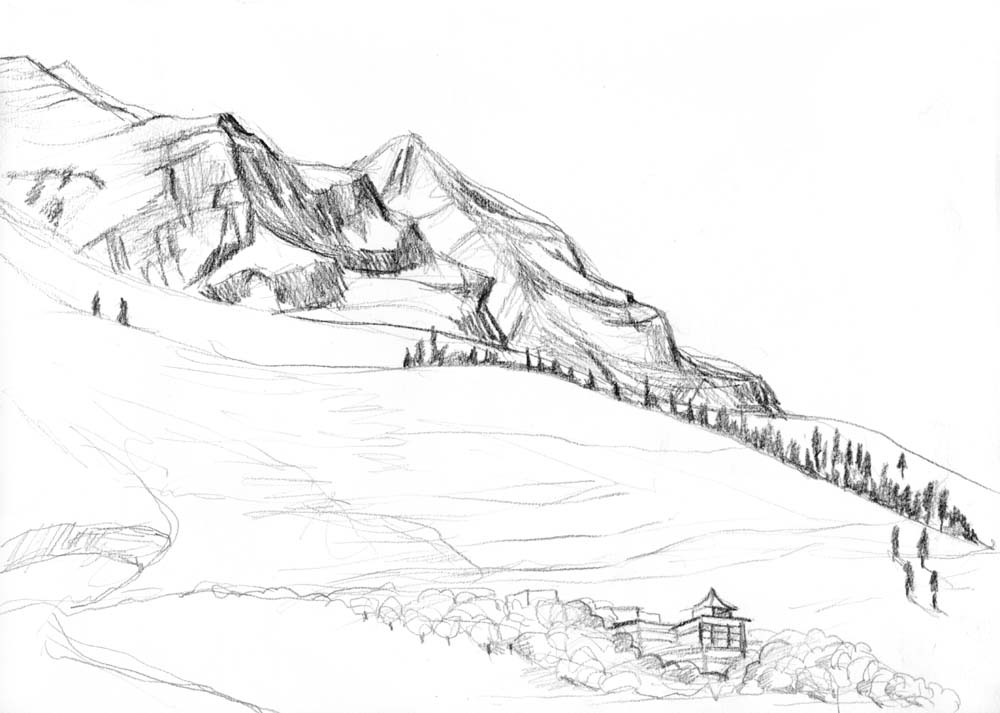
Just before we reached the apex of the pass the vehicle had an electrical shortcut that produced smoke billowing out from beneath the control panel. For safety reasons we all rushed out and the driver detached the battery and poured water over the smoking area. To get the diesel running after this operation was a bit complicated. The driver had to turn the ignition key while someone else had to connect the battery for a short while to start the engine. Luckily we could continue our journey to Keylong and we arrived before the onset of darkness.
I am the only guest here at the restaurant and they seem to take their time to cook my meal. I wonder how much stuff they must be keeping on their shelves in terms of ingredients to fulfil their rather extensive menu.
Now the mountains are no more than dark outlines. From the mountains in the far side there is a dim light coming from a monastery. It must take an arduous walk to get there.
2nd of August
I am waking up in a bright and spacious hotel room by the sun and the sounds from the bus station. I stroll down to the high street for a breakfast in the more orderly tourist hotels and find a calm and peaceful seat for this early hour with a view over the valley. A pear tree is heavy with fruit in the kitchen garden outside below the window, and a cow is munching on hay in a small stable. The meal was expensive but the view made it worthwhile. Later on at the bazar I found a traditional dhaba with a view over the mountains and the valley. This is a place that I used to revisit in the days when traditional dishes such as pakoras or samosas and all the other Indian treats were so much cheaper. I watch the flat rooftops that were used for drying hay for the animals. Prayer flags flutter in the corners from the remains of reinforcing bars that extend upwards. The owner of the house has left them in order to build another floor and then another one determined by whatever the economy will permit. The houses are rather wobbly after all these extensions and pose a potential collapse hazard.

I can see the long trail on the far side of the valley that is leading up to the Buddhist monastery. Monasteries are supposed to be inaccessible like that, and it is the proclivity of an ascetic that could make someone wanting to get there. There are many monasteries that await me in Spiti.
The TV is on, there is clatter from the kitchen and cars are running by. Despite everything else there is an enormous stillness here in the remote and peaceful town of Keylong. It is a one-night place for all the convoys of vans and motorcycles on their way to Ladakh over the Baralacha La pass.
A crooked old woman puts out hay to dry on the roof. It is manually cut grass for the cows to eat during the harsh winter. She is careful about airing it by pulling the strands apart before placing them in neat rows at a low level so the sun can dry it quickly.
I meet the poor people of this town, the porters at the bus station, those who live in huts below my balcony. Poor people always seem to be among us, the needy, people who need help.

Our character is found deep within ourselves, in our bones and marrow. Education makes character through reprimands, admonitions, and encouragement. Standards are given from parents, acquaintances and people whom one can admire, and they serve as role models me making it possible later for me to be a role model for others. I do not know whether or not I serve as a role model for anyone. I don’t care; however, I do not want to be a deterring case either.
I slow down my pace and look around. Life is so similar everywhere on Earth. We come from earth, the earth feeds us with water and the air makes us stay alive. I eat what the Earth provides me, I drink water and I breathe the air. What more can I ask for, what else is there to understand? Emptiness, all void, says the preacher, everything is emptiness.
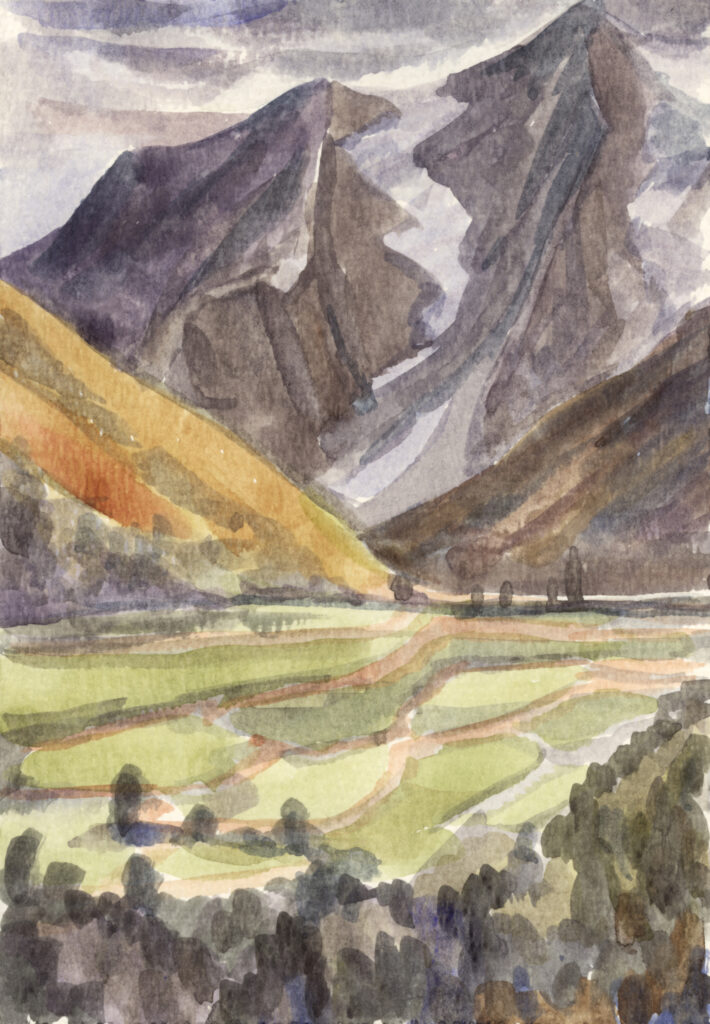
3rd of August
I can stand before these mountains for eternities. Glaciers run down from the high passes and the valley floors. Melting water is guided to the green fields that surround the small villages where life is going about as usual. The mountains writhe and turn around. What seemed to be the inside becomes the outside next moment, shifting with the light changes. Sometimes the mountains seem so close, sometimes so distant. The mountains are in constant motion, mutable. What is now mountain has at one time been the sea floor. Calm as mountains, yet undergoing transformation. Perhaps mountains think. My little beating heart is so weary, finds it so difficult to be quiet.

Spiti
4th of August
The journey from Keylong in Lahul to Kaza in Spiti was long and exhausting. I couldn’t afford to be late for Grampho where I should catch the bus on the route from Manali to Kaza. We were late, but as it turned out, the bus from Manali was late too. All seats in the bus were already taken so I had to travel standing for the most part of the trip. The road was stony and bumpy, flooded by water streams and fallen boulders that had to be passed with great care. We had a short break at Kunzum, the highest pass located at 4 500 metres of altitude, where sheep grazed the pastures and the prayer flags fluttered around three large chortens as an expression of gratitude for a successful journey so far and a prayer that it may continue that way. The expedition then proceeded from Kunzum La in the deafeningly noisy bus on a road of flattened gravel that had large potholes and cavities in it. I finally got a seat in the rear of the bus which made the fare even bumpier. Glimpses of the dramatic scenery outside passed by, rock formations, deposit rock, and erosion precipices. These large gravel slopes are formed by millennia of rock erosion leaving a peak from the more resilient core and can be of many strange shapes.
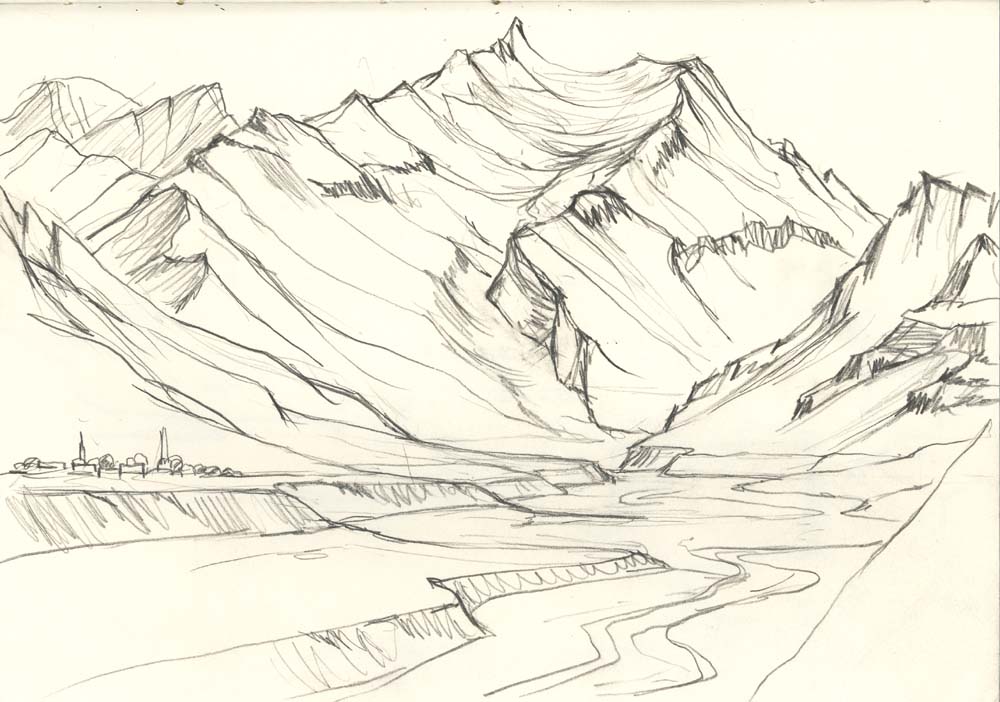
At last we arrived in Kaza which is the capital of the Spiti area and more Tibetan Buddhist than Lahul. Here I found a charming family hostel that offered a nice clean room.
The valley is surrounded by dramatic mountains that have weird shapes and colours. Houses gleam white from sunlight in villages that sit on the cultivated strips along the river. The river comes from the glacier wells and meander forth through countless generations of gravel sedimentation. The landscape is magnificent and the air is crystal clear.
There’s a bit of a Klondike spirit here. The people of Spiti, Indians from the plains, and people from Kullu and Lahul are seeking the treasure and they want their fair share of the tourist gold. Hotels and restaurants have popped up everywhere and many of them have no idea how to run their business. There are internet cafés, a German wholemeal bakery, a cash machine, Tibetan restaurants, Indian stores and a lot of guesthouses where one can stay in the family house or in an detached house.
My journey has sort of reached a touchdown. What remain is hurling myself up to Ki Gompa which is my final destination. My stomach is upset as usual after a ride. I’m taking it easy for a couple of days. I can sit on the roof terrace and watch the mountains, and do some painting or drawing.
5th of August
I’m sitting on the outside of a restaurant with a view of the mountains. I need to get into a better mood but the reek from waste and draining is intrusive. How far has common sense about the environment, cleanliness and ecology really evolved here? One can see advertisements about far reaching projects set up along the village road. Directly adjacent to the restaurant there is a cowshed spreading its own fragrance. Dung belongs to the realm of natural odours but not a brilliant idea to have next to a restaurant. This is one of the drawbacks of the eagerness of the Klondike spirit.
When the mountains are at a distance I can see the large structures and my imagination fills in the details. The slopes are scattered with patches that are lit up in shades of green, turquois mixed with terracotta and ochre. Left at the top stands the columns in violet and grey against the blue sky.
The chef is on the road, and those that are left in the kitchen can’t even cook a vegetable soup. I file a complaint and leave without having to pay.
The beautiful weather, the nice old houses and the marvellous landscape puts me in a good mood. I walk to the Gompa in Kaza, a new monastery that is looking like a palace with a mighty view from the portico. The Nepalese and the Tibetans have contributed with handicraft work, paint and fabric. The inside is one large sacred room filled with artefacts, Buddhas and relics. Ritual paraphernalia are laid in a corner together with a photography of Dalai Lama from 2009 when he paid a visit to inaugurate the monastery.
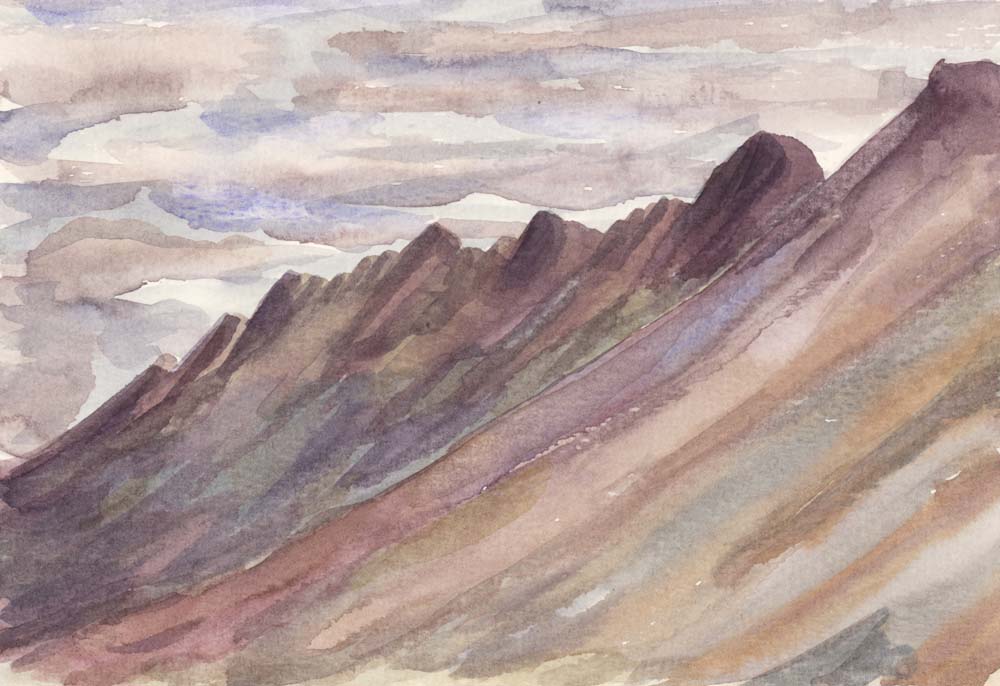
On the outside you will pass a Mani wall covered by stones that have the inscription Om Mani Padme Hum, the mantra that contains the sacred syllable ‘Om’. I stroll around a chorten on my way down to the village over a bridge that is crossing the largely drained tributary. Poor day labourers are carrying sacks full of mortar up to the mason who is working on a construction. Would the inhabitants of Spiti ever do that? City dwellers, peasants and farmers from Spiti seem to be well off with their nice houses and comforts like electricity, tap water, lavatories, TVs, radio, and mobile phones. They take advantage of the poor people that come from the plain-lands of Bihar and have them do the most part of the heavy construction and road work. Their worn tents line the roads outside the town.
Here is a small Klondike but no hysteria. The fact that there are more guesthouses than tourists makes it all rather peaceful. The roads are in bad condition, and there are stray dogs everywhere. The tourists stroll leisurely by taking photographs of everything. They need to pose restrictions upon construction work, environmental and vulgar tourism arriving by air, obese dollar tourists, and all kinds of drug abuse, like it is Ladakh. This is still a pristine area.
6th of August
I encounter so many nice people but I am stuck inside my solitude. My body, my sensory organs and thoughts mirror the world, and are construing the world. We shape the world the way it looks, its appearance and content is our own creation that we experience through others and by ourselves.
Two women stroll by. They are young and attractive and travelling somewhere. Perhaps I will see them again, perhaps I’ll get to talk to them.
We are located at 3 800 metres of altitude and it is insanely hot in the sun at noon. Shops close between 1 and 3pm.
I experience total stillness and tranquillity in this village. My body is the only object I’ve ever known, the landscape, colours, shapes, momos, the noodle soup, the lichy juice, samosas, cow dung, perfume and incense. The glory of the Earth, the pulse inside me, the rhythm that separates now from then, one event at a time, the relaxation in my body, its breath.
Yet I’m not always there, not always calm. I am weary but the journey induces peace and harmony. The journey proceeds at a slow pace as I draw, paint and write.
Being creative is my whole approach, being creative belongs to nature, its genesis, and each moment is an act of creation, intentionally or unwillingly. It starts somewhere deep within me, beyond sexuality, hunger or thirst. Its content or meaning is not immediately up for conjecture. Everything has its own meaning. In time and space we have to contemplate the value in its own terms, both now and in the future.
At the deepest level inside of me I keep my thoughts about eternity and contingent bodily needs. The monks that are here seem so peaceful, humanitarian, and kind. They have been meditating over the ephemeral nature of cosmos and found the quintessence of their own being which is overt peacefulness, perpetual seeing, perpetual awareness, the origin, and the act of creation.
I am driven by the desire for sexual release, satisfaction, fame, and approval.
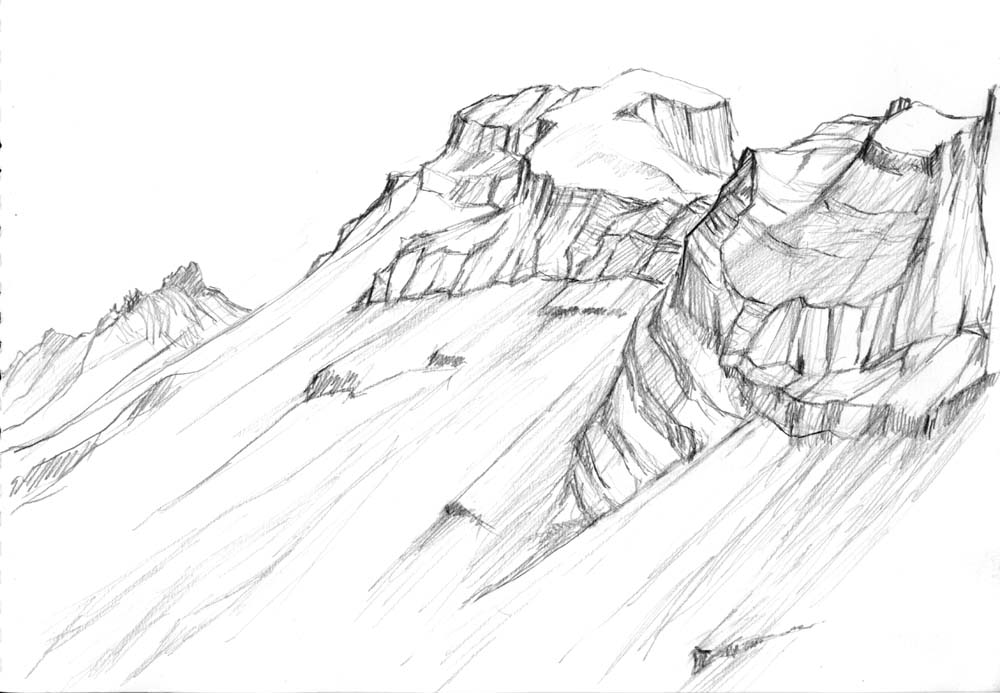
Here I am, I don’t have to achieve anything, don’t have to meet any objectives, only listen to the rhythm inside. From bone and marrow come intentions and unwillingness; who am I to decide? That perpetual motion, being and becoming in the world!
Is my own philosophy of any use for me? Writing is taking me forward and protects me from insanity. The world would be a benign place if everyone would remember and realise their good intentions.
The world is new for my senses and for everyone who is born. Satisfaction lives within, everything is changing, altering colour and shape from this moment to the next. I am monitoring the movements in my awareness of how objects transform. Am I capable of noticing my own transformation?
Suddenly there are so many Westerners here. They are all going to Ki Gompa for the festival tomorrow. I am going there too, for a reconnaissance. My idea is to stay there for a while. I feel good after a lovely day and my painting is beginning to shape up.
Electricity is cut off about seven when food is served. Luckily the kitchen runs on gas and the restaurant owner places a big gas lamp in the middle of the room. Chinese and Tibetan food is more agreeable to my stomach; Indian spicy food makes it upset. My stomach has better memory than I do.

7th of August
People gather from all of Spiti to attend the inauguration of a new sanctuary that gazes over the valley and located a short walk outside the monastery. A Holy Llama from Delhi has paid a visit to bless the somewhat unsightly temple which has rigid and lifeless sculptures of three bodhisattvas (4). The Ki Gompa monastery, however, is a splendid sight located at a spectacular spot. Built in conical form around a small mountain peak, its uppermost level houses are the meeting halls, libraries and kitchens. Below in consecutively wider circles are the living quarters with labyrinth pathways between the houses. Here I was, in real life. I have reached the goal of my dreams like I saw it on a picture more than a year ago. The monastery was built in the early 11th century at an altitude of 4 100 metres above sea level. They had their millennial celebration a couple of years ago when Dalai Lama inaugurated a new ceremonial hall. Some hundred monks here run both a training course for monks and an elementary school for neophytes.
The morning started off with ceremonies in the grand hall for monks, Llamas, and long distance guests coming all the way from Singapore. The most prominent monks resided on the throne at the far front from where they spoke at great length. Gifts were exchanged and recitations from the Scriptures were heard backed by musicians. A procession of visitors brought forth offerings. Women from a village in the Spiti valley, dressed in festive outfits that were adorned with a mat of turquoise stones over the shoulder and finely chased silver jewellery hanging from the hip, carried offerings such as seeds and yak butter. After lunch a presentation containing folk dance accompanied by songs, and music commenced and went on until late afternoon. Thousands of visitors from Spiti and surrounding villages were following the ceremonies and the dance. The monks, dressed in stately yellow hats, performed a slow dance to simple drum beats. Breakfast, lunch and dinner were served with no charge at all and packages of sweets were handed out to the children. The people had put their finest clothes on and children ran around with windmills.
The Llamas greeted all the dancers with kathas, white scarves made of thin shiny polyester fabric. A nobler katha, like in the old days, should be made of silk. Offerings were presented, such as rice, wheat and yak butter, and gifts like rugs, thankas (altarpieces) and pieces of cloth. The monks of the monastery served the food. Donators among the visitors had paid for a large portion of the event. The meditative and quiet spirit of Tibetan Buddhism tends to exaggerate their life affirming mythologies and stories conveyed in dance and art which makes it popular. Sending a son or a daughter to the monastery to become a monk or a nun is regarded as honourable by every family.
8th of August
Overcast today with scattered showers of cold rain. I’m sitting down exploring my body’s and its constant activity that is both conscious and unconscious, all of it from the toes up to my brain and hair strands.. This universe is infinite within us, infinite without us.
Being present in awareness of all that is, what I am and what humanity is. The child that is experiencing its entire self, screams from pain and cries when left alone, laughs from pleasure and blissfully dreams itself away into the inner landscapes, resting in its mother’s lap.

Suddenly I am aware of sex only, the big sex that wants to penetrate and find release. It is primitive in some way, unsatisfied desires, no merging with another, no ecstasy, no memories to collect, no wide open heavens; nothing of that, just the need for erection and ejaculation.
I create the world with my words, embracing it with my thoughts and animate it with my action.
The world exists out there and inside exists my perception of it. It is becoming truer and more abundant as the years pass by.
I’m watching a family that has two kids about 8 to 12 years old. It’s a good age to bring them along on a trip somewhere. Curiosity and lack of prejudice is good for making new acquaintances due to the child’s spontaneous candour. The children here seem so ingenuous and happy.
It is raining in Spiti, highly unusual but sometimes the rain season spills over here. There must be torrents of rain falling on the southern side of the Himalayas for there to be anything left of it here.
It’s still raining. A pity for I soaked my laundry in water this morning and now air humidity is rising which makes it impossible for my clothes to dry.
Whatever I am doing either becomes a burden or a lasting strength. Good deeds forge character, empathy, understanding, sympathy, humbleness before existence, insights into difficulties but also joy.
9th of August
It is a peaceful morning with birds twittering in the trees. The sun is shining from a clear sky; it’s going to be a hot day. I have to admit that my body is slowly getting old. It’s important to keep up shape, eat reasonably and exercise a lot. I am thinking about all those words of wisdom about health and food. I think about the necessities of life, not the excesses.
Words of wisdom about how life is supposed to be lead, like those I have written myself. They have to be practically implemented so one will remember them, not only as words but as actions. That is what makes living work. Small acts, that are hardly visible but noticeable. About things that lie ahead, anticipating, proactive. Simple things take time.
There’s freshness in the air now after the rain. There are many young people backpacking up to the mountains. I hope it’s going to be safe. For myself, the journey is more about rest and reconnaissance. I will go up to Kibber for a couple of days, then back to Ki Gompa for a few days. I also want to visit the beautiful and spectacularly constructed Dankar Gompa, the former capital of Spiti.
Man is making plans and trying to meet certain objectives. Out there in nature you have the overviews and the outlooks. The mountains stand immobile, almost. Their time scale is geological, slow. Watching the mountains provides a peaceful break. Immovable they are, still but with ever shifting colours, light and shape, assuming new forms during the course of the day. What else do I need apart from sitting down watching the mountains?
10th of August
Located at 4 235 metres up Kibber is a small village on top of a mountain ridge. The morning chill is palpable. The massifs are towering on every side and it is peaceful. People grow barley, peas and beans. There is a flea market held here every year that has visitors coming from all parts of India.
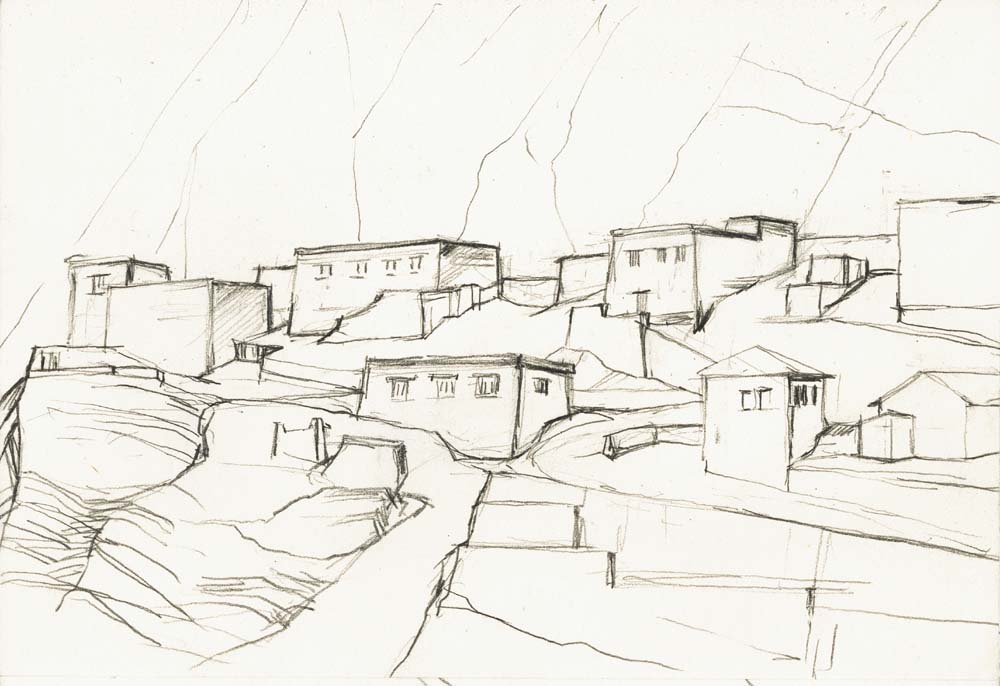
I took a long walk that up the slopes lasted all afternoon. Miles wide views with the contrast between smooth rolling slopes and spiky aggressive mountain peaks. Long eroded slopes have left the solid cores standing.
Kibber is a charming village with farmers and cattle. Adjacent to the houses are stables for cows, sheep and goats. Many houses of traditional constructions have a floor of tamped clay, but some of the modern houses are built with a concrete framework and concrete blocks. The roof is held up by a heavy iron beam or a massive wooden log across which are laid tree trunks fifty centimetres apart, across which in turn, are laid pieces of split logs that cover the roof completely. Above it all there is a plastic rug and more tamped earth. At one edge of the roof there is a low wall that has tiny holes in it to drain the water. There are heaps of hay that is put out to dry for animal feed during the winter.
I do not seem to be a particularly attractive individual. I might not always be very accommodating towards others. I need to be more receptive towards change, towards new acquaintances and opportunities.
11th of August
This is my second day in Kibber. The sky is cloudy in the morning hours and the chill creeps in when the sun doesn’t show. My dreams during the night were strange; was it the altitude, the warmth of my bed, or was it loneliness? The morning bus to Kaza is droning outside the guesthouse and getting ready to depart. I am having my breakfast looking out over mountains 6 000 metres up and partly illuminated by the morning sun with specks of green here and there between yellow, ochre and grey lines from the erosion slopes. The hard rock is left standing on the top extending upwards in fanciful shapes that mimic watchtowers, fortifications, castle walls or dwellings.
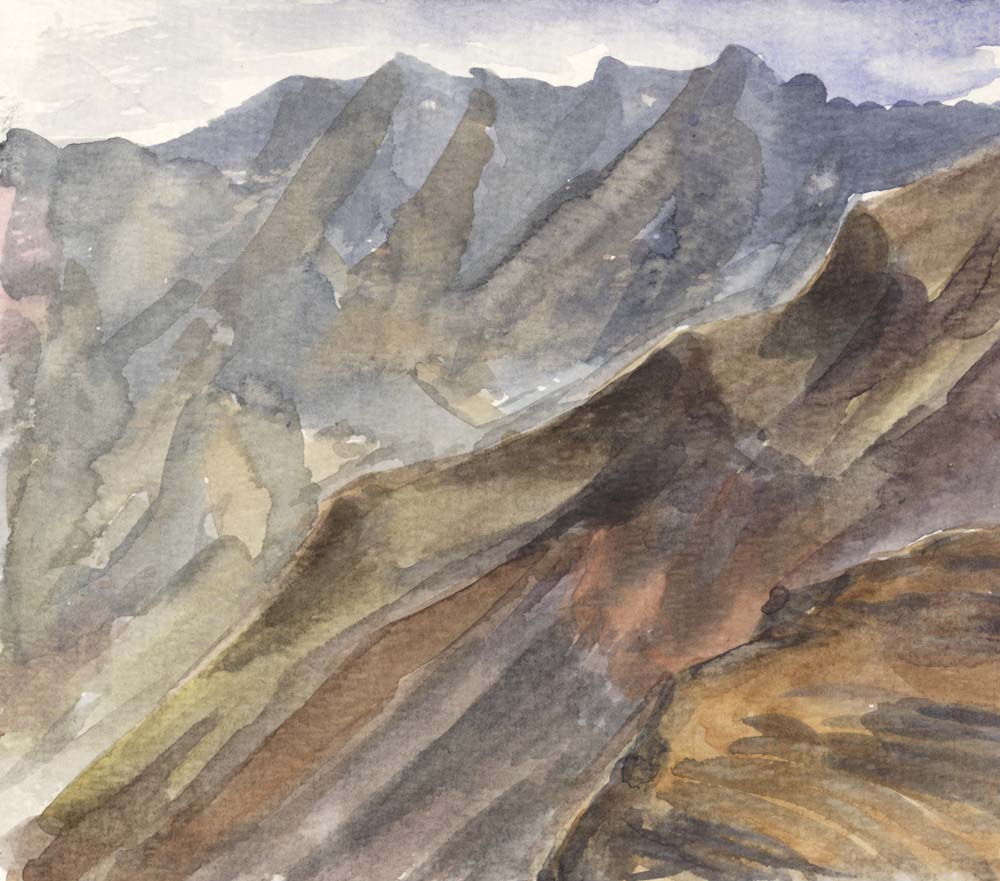
The village has sprung to life hours ago. The birds twitter, cows moo, women chatter between the houses, sheep bloat on their way to the herding site, cars honk and a big tractor rumbles by with an empty trailer. The farmers have sheep, goats, donkeys, yaks, or a breed between cow and yak that doesn’t have much wool but leaves more milk. Here and there one gets a glimpse of real yaks, woolly with extremely rich milk.
The morning bus leaves with each seat taken. I’ll stay here for two more days. I am drawing the village and the view towards the mountains. I have brought the water colour box forth and I am getting familiar with all the colours I see in nature.
I was twenty-two when I started travelling, for the most part alone, more sporadically with the company of others. I have never been lonely in India, here are always connections and a sense of really getting in touch with people.
I met two Canadian girls that were travelling together. They sleep in the same double bed, spend every day together playing chess, chatting with other travellers. Their friendship could have started in childhood, they enjoy their freedom, and perhaps they have a love relationship. They are on holiday before the start of their university studies, they explore the world and that is going to give them memories that last a lifetime.
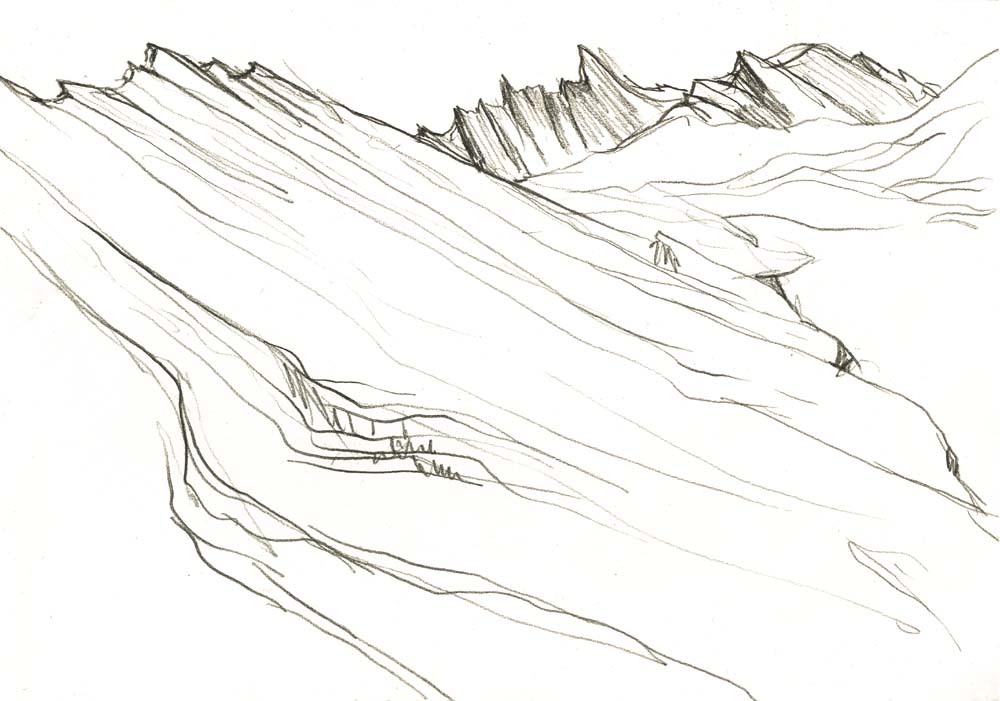
The sun is coming out, almost at zenith, and immediately starts to burn for this is 4 200 metres above sea level near the tropic of Cancer and without any air pollution. It makes my skin sore immediately so I have to apply the sun screen I have. The full moon is visible above the horizon; does that make one more crazy, being closer to the moon?
I walked up to the peak behind Kibber. The mountains seem so palatable and huge. Here I am, close to cosmos, what is needed beyond this experience? Memories add depth and understanding to the now, to the presence of the senses, the feeling of heart beat and the breath of my lungs. Different formations made a contrast to each other during the sunset. The moon wandered above the slope. The last sunrays lit up the mountain peaks in the distance and the clouds reflected back a golden shimmer. The chill increased as did the wind. The twilight was magical. I realised why they chose this site for settlement, perhaps after a journey over the mountains from the Tibetan highlands filled with hardship. There’s nothing but the wind in my ears, motionless mountains and the rapids that are barely noticeable.
The nocturnal full moon illuminates the landscape. Dogs yap in the distance, voices from people on the way home, lights are turned on in the houses. The mountains look dark and powerful against the dark blue sky. The stars twinkle faintly beside the brilliant moon.
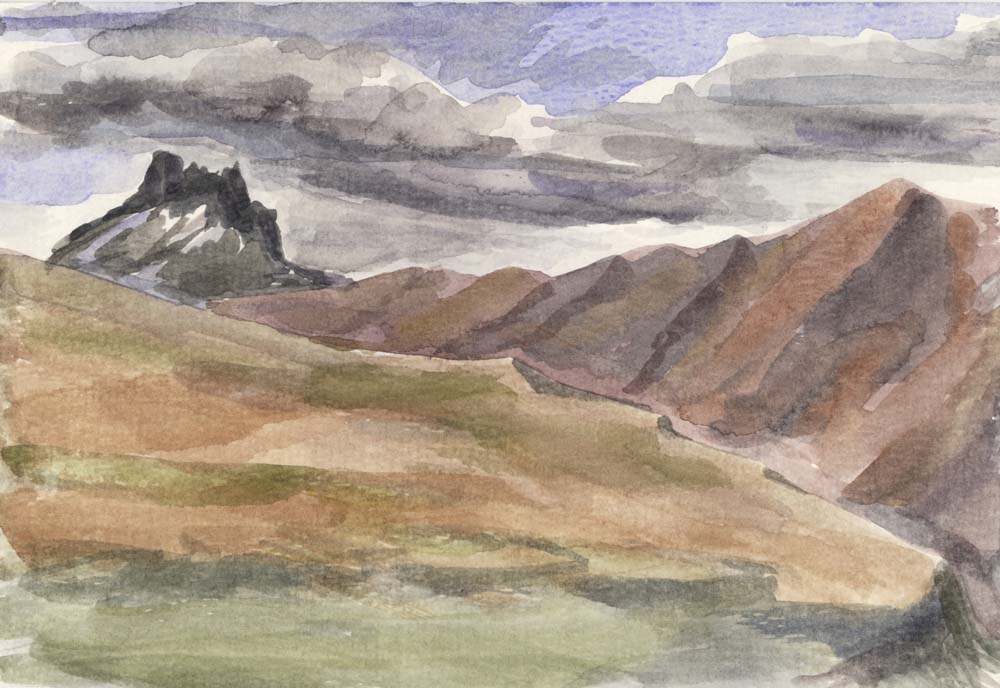
12th of August
Looks like it’s going to be a clear day today, splendid for a longer walk to the mountains. I’ll bring an extra supply of water and provisions and will set off to reach deep into the mountain.
I am looking for fossils from the Carboniferous, Silurian and Cambrian periods which are said to be plentiful here. A man from Belgium has stayed here a couple of days and assembled an impressive collection of small petrified sea creatures that are lined up on his windowsill. Of course I haven’t found any, not even one. Perhaps one needs training in fossil exploration to know where to look.
Deep into the mountains I went, but I didn’t feel very well, perhaps due to a combination of oxygen depletion, a common cold, and a troubled stomach. The sun was burning hot until 1pm when I reached my turning point. I rested but had no real peace because of the flaming torch from the sun. Following an irrigation canal to its source made me completely exhausted. During the last bit the water was guided past the damaged and eroded parts of the ancient system – the lifeline for the earlier settlers – through thick black plastic pipes.
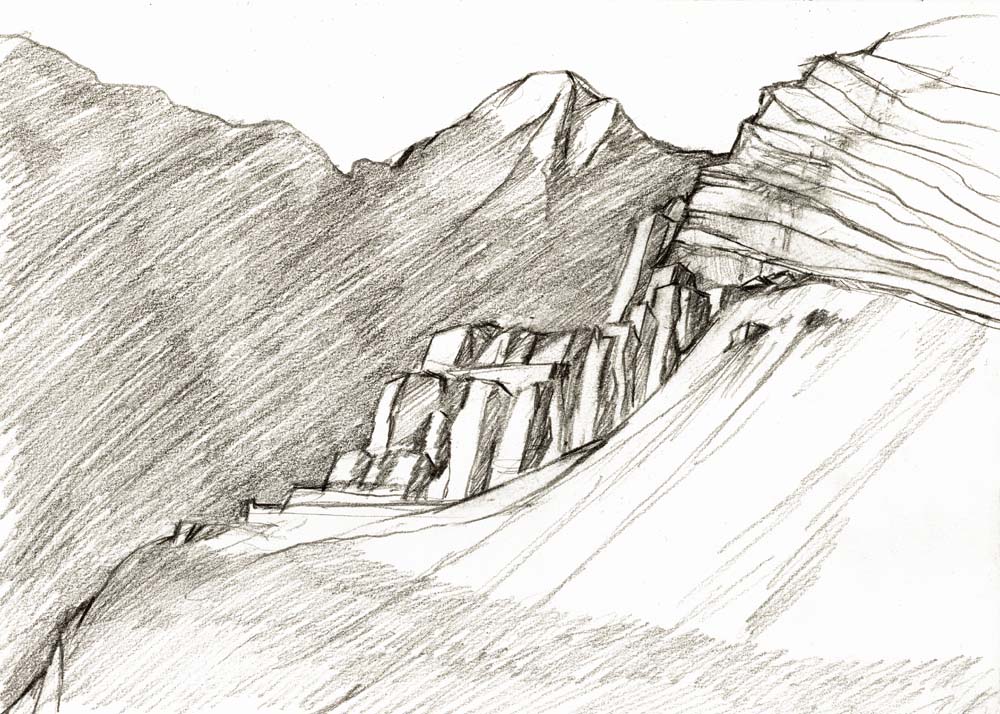
The mountains receive a rather flat kind of light during the middle of the day which is enhancing their colours but it doesn’t make them interesting. During the walk back in the afternoon I got into a slightly better mood and had a lot of water to drink. By late dusk the mountains became dramatic. But the wind started, an icy wind coming from the east, and I had to put on everything I had brought along. Got home with only a few drops from the sky. Later in the evening the dripping continued and the temperature dropped.
13th of August
The clouds hover heavily over the mountains. Still dripping and the prospects of painting are not good. The weather is going to decide whether a stop at Ki Gompa on the way down, the goal of my dreams, is going to be worthwhile. May the weather be fair so I will have sufficient time to draw some of its architecture.
I got a wonderful room at the guesthouse in Ki Gompa; I could stay here for a long time.
I am sitting and looking out over the valley where the villages are dispersed like green oases in regular intervals surrounded by cultivated fields that spread down towards the river bank.
Young boys, Buddhist novices, are watching TV in the dining hall looking at action movies, B-movies with a lot of violence in them. They are almost glued to the TV screen. Is this an integral part of a well-balanced education? Do they get to read any books other than the Holy Scriptures? Do they play football and computer games? Perhaps this belongs to the education of novices, awareness and enlightenment. They know what they are leaving behind.
Dalai Lama is looking down from his photography. There are
other religious leaders like lamas, enthroned in the monasteries, hanging together with thankas (5) and mountain views.
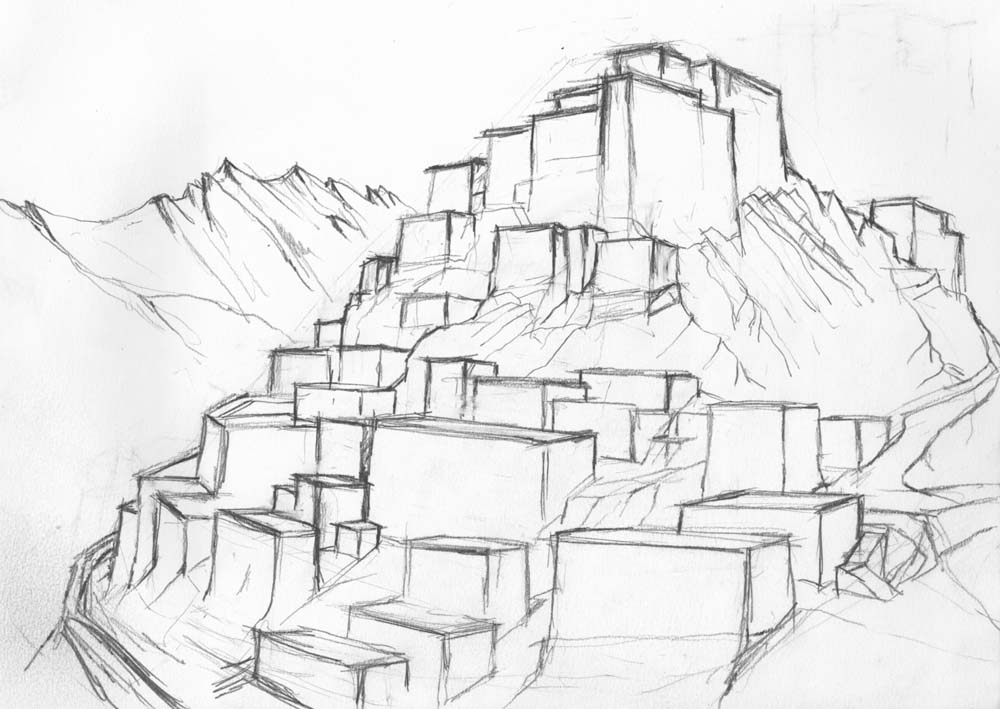
Ki Gompa
This thousand years old structure has been extended and built upon with intricate pathways between the houses on the slope to the south where most of them are located for the sake of saving heat. There is the chamber with the memorial chorten over one significant llama, a bedroom where Dalai Lama stayed during his visit to perform the inauguration of the new ceremonial hall, and a meeting hall at the apex. The walls of the kitchen where we had tea were solid black from the soot coming from oil lamps that have been burning for centuries. At the forefront of the meeting hall were seven bowls of water representing various forms of Buddha’s sacrifice of his own water. The English spoken by the guide was far too unintelligible for me to catch the full meaning of it all (6).
There is nothing left to yearn for, I am somewhere in the midst of being. Yearning is an illusion that distracts us from the now. I see the light from the surroundings, the clouds that race over the mountain peaks. It’s cold and dripping of rain.
The memories of the soul, the infinity of the now, the unspeakable and unfathom is able value of being, love of all that lives and dies. We all die to be part of something. Of that we know nothing, of what is there beyond. Only the joy of being here, feeling the pleasure of awareness, our intellect and the flow of thoughts. Things that happened yesterday will enrich the now wherever needed; it’s coming to me effortlessly, spontaneously.
Sexual memories of erection and penetration dominate the mind. You cannot be liberated from sexuality that easily. It’s there, the desire for release. Can it be that simple? The entire need for human presence is there, for embrace and intimacy, scents, sounds, nocturnal whisperings.
The monk novices are here again watching action TV like Pirates of the Caribbean starring Kira Nightley and Orlando Bloom. Malevolent creatures, octopus men, combats between pirate ships, supernatural ships, cannons firing splintering ships and mutilating people, pirates and shellfish men. They don’t watch the film to the end but instead they switch over to some Hollywood production that is dubbed in Hindi. More tourists are coming to the hotel; soon every room will be taken.
From within, from the inside, from within every decision must be made. All these superficial reasons, these threats, these personal motivations. Don’t need fame, yet I struggle violently to get it. I don’t need sex but I will never escape it.
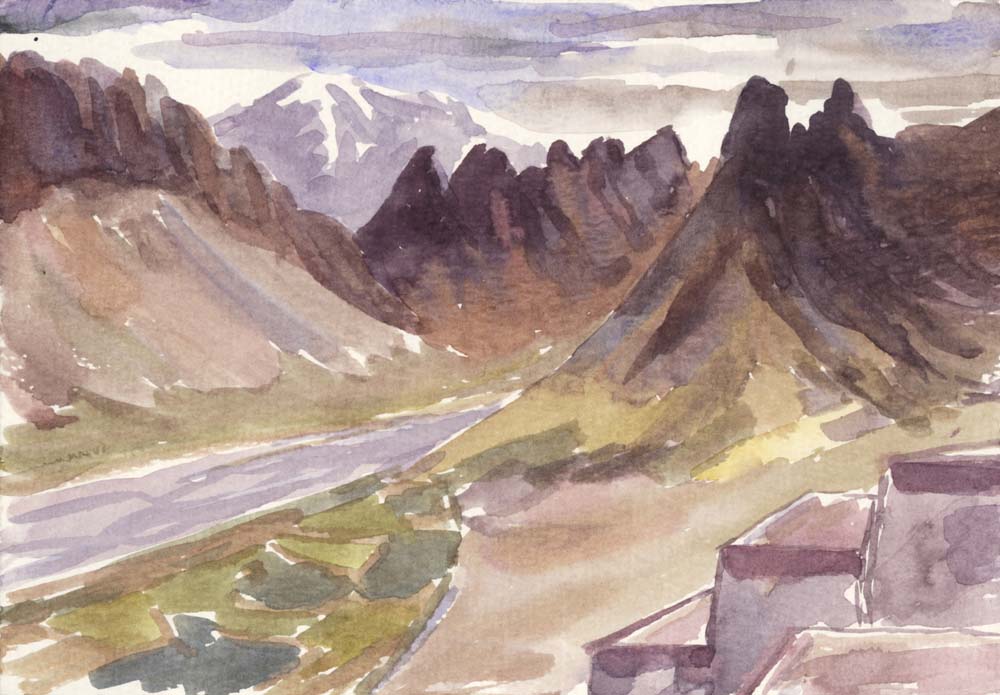
For these energetic and cheerful novices, next generation Buddhist monks, the world is out there, the knowledge of which is not denied to them. Still there is this transition to, and training for, a life in meditation and understanding. They are going to see that there is no depth out there, only superficiality. There is no joy out there, only suffering and desire. There is no wisdom, only intellectual knowledge. There is no real enlightenment, only repetitious learning. Buddhists have their mantras, recitations, repetition of theses, and exegesis. There is also the teacher, the erudite Llama who shows possible courses of conduct. Real knowledge may only be accessed by action, a practical application of what is heard.
Now they watch Tears of the Sun. I saw it a long time ago and it’s a rather cruel movie about a war in Africa based on a real story with the main character Bruce Willis in a part that is not entirely convincing.
The weather has to improve. Sitting inside all the time won’t do. The clouds loom heavily above the mountains.
I have left my Kullu cap up in Kibber. The landlord will surely find it. I have sent a text telling him to leave it in Kaza when he gets there for the festival.
14th of August
I had strange dreams this morning with friends defiling by and I couldn’t get in touch with them.
The colours of the mountains across the valley are tinted in ochre and moss green and the bright green of the fields mix with yellow patches and the red mineral in the rocks. The sun shows up illuminating the valley floor dramatically making the colours flash while he mountain peaks disappear behind the clouds.
The TV is on again, it’s cricket this time. The monks are completely absorbed by it, both young and old.
Black ravens are common here. They fly in swarms through the valley. It’s clearing up and the temperature is rising with the daylight. My belly has got its share and my mood is improving with the brightening of the sky.
The morning bus to Kibber has arrived, about nine o’clock. Some tourists step off. It’s a family with two kids. He is Indian and she is a Westerner. He speaks lovely Hindi with his children and his wife.
About lunchtime the two Canadian girls pop up greeting me cheerfully. They are going to stay for one night. An elderly gentleman comes in with a huge knapsack, sweaty from a long walk. Everybody is sitting down reading or eating having a bit of contemplation during the middle of the day. I try to converse with some Westerners who speak with various degrees of broken English while the sound from the TV is banging my ear.
The weather is unstable but the sun is shining between the clouds and I go out. I draw the monastery twice, one close up and one attempt at catching its structure as a whole. Its perspective is tricky for it is turning around a mountain with different fixed points.
I walk clockwise around the monastery accompanied by a monk with a so called ‘kora’. We talk about this and that, the weather during winter, or the height of mountains in Sweden. He wants to learn some English words, but we speak Hindi most of the time.
Another cloudy day and an attempt at water colours in the dining room.
Waiting, eternity is here, nothing to yearn for, only being present in the now. Tourists come and go, staying for one night and departing the next day. This is a transit site. Very few stay to meditate in the stillness, the light, the buildings or the presence of monks. Waiting for what? I exist in the midst of murmurings about where to go, what’s worthwhile to see and what is coming next. They wait for the bus; waiting is a tourist’s way of life.
These overloaded motorcycle tourists riding their 350 or 500 cc Royal Enfield Bullet! Guide, mechanic, petrol and rent must have cost a fortune. The bad and hazardous roads must be very difficult. The appeal of freedom perhaps, racing around through mountains and over vast expanses. You don’t have to wait for the bus.
I am sitting indoors most of the time painting. It is raining and it is cold. I am a bit nauseous from the food. I am conversing with a young Israeli girl. A Canadian woman and an Indian driver who is also working as guide come in to the room. They are uncertain about the weather and which road to choose. The rain may have ruined the roads to Kunzum La. They will try to get there anyway. I see them next a day later when they had turned south instead after a full standstill in the mountains.
It is raining over Spiti and the air feels cold. I need to put on all that I’ve got of long sleeves, shirt, woollen sweater and scarf. My hands are freezing. I grab the opportunity for a walk around the monastery when the rain stops and follow the monks on their daily “Kora”(7) during the afternoon. The clouds lie like a flying cotton blanket over the valley wrapping the peaks while leaving a clear view of villages, roads and distant fields where the meandering river is gleaming faintly. Prayer flags flutter in the wind, monks sway their prayer wheels while they meticulously circle a boulder on the left that has an inscription with the word ‘OM’. One of the monks shows interest in my drawings. He is doing some drawings himself and wants to learn more. It must be a dream job to come here and give drawing lessons!
16th of August
The bus that is going along the winding road down to Kaza is filled with peasant women who stepped on at the village below Ki Gompa. The light that is filtered in through the windows gives a mystical shimmer and is accompanied by the women’s religious rhythmic singing where each phrase ends ‘with Om Mani Padme Hum’. Where are their contagiously joyous laughter, healthy spirit, and solid self-esteem coming from?
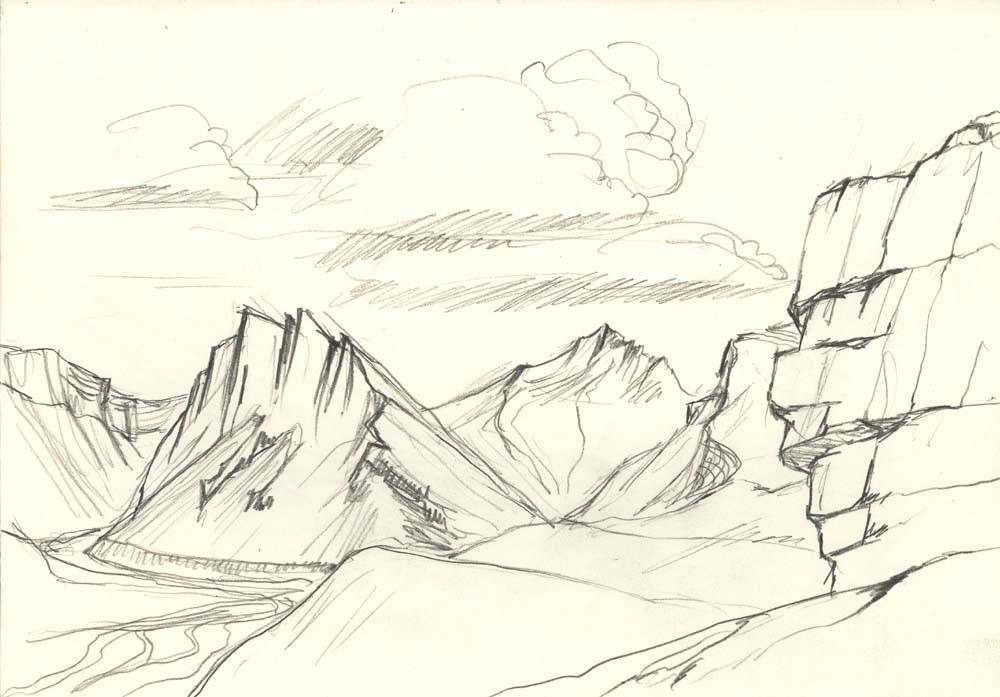
I’m sitting and looking out over the town from the exterior balcony of a guesthouse in Kaza. The clouds still rest heavily over the mountains. It’s warmer here compared to Kibber. Birds’ twitter and cows’ mooing mix with the chatter of people at the local construction site. The garden is bourgeoning with flowers. The guesthouse is nice with a sense of homeliness to it. I spot a trail that is going up over the mountain and I’m looking forward to an excursion to views that have not yet been seen.
I met a young and happy girl at the coffee shop who is volunteering at teaching English to nuns further down the Spiti Valley. Her parents are Chinese and she was raised in London. Soon she will return to the nuns after the holiday that celebrates the independence day of India the 15th of August. Some twenty-five nuns are going to learn how to articulate English words correctly, which is a luxury in these parts of the country. She took the opportunity to hang out at the internet café here in Kaza since network connectivity in the village is non-existent.
People meet and talk about their life, experiences and wishes, saying hello, saying good-bye never to see one other again. Such acquaintances are transitional, enjoyable, and stimulating. Can one reach any depths here? I may be like an open book. People read me more than I imagine. The outer world for me is like a book to read and to contemplate.
The poor are always among us, like the man with crutches at the Bazar; where is he coming from? Or those poor people in the tent camps outside Kaza; where are they coming from? The residents of Spiti sometimes employ poor people from the plains short-term for construction work. Households nearly always keep a small boy or girl from Bihar as servant. Spiti people live in good houses, all their children attend a good school and there are homes for the elderly, a post office, a bank and legal services. They really should have had a home built for these short-term workers. But they are delegated outside of the Indian government’s funding strategies for securing a sustainable population in the areas near the China border.
Tourists stroll by looking about with flickering eyes, experiencing, taking photos and notes. There is a documentation process going on that has no equal counterpart in history. The locals contribute by taking pictures with their mobile phones.
The road down to Manali is closed, flooded, washed away and snowed over. The roads to the south are the absolutely only options in terms of accessibility. The bird life here is tremendous. Birds are migrating south through the valleys before the winter strikes.
17th of August
I have weird dreams. Something is wrong with my body, don’t know where it’s coming from.
A month has passed, one month left for travel, adventures ahead. There is nothing sweeter than the warmth of the sun after several days of rain, overcast sky and cold weather. However, the sun is burning mercilessly and I have to protect my face and the deforestation that is my head. The shades offer a pleasant coolness. I am altering between shuddering and sweating. A scarf that can easily be taken off and put on is the ultimate piece of clothing.
The mountains stand in their naked beauty slowly crumbling down to become undulating hills while the water is digging small canyons. It’s difficult to pave for roads when they are flooded by gravel and sand from violent torrential rainfall. The roads become blocked by detached boulders on the run. About one million years from now the Himalayas will have turned into gravel, the glaciers will have melted and all of it will be transported down the rivers forming enormous deltas far out into the Bay of Bengal. However, they have allegedly determined that the Himalayan peaks still continue to rise, so the Indian sub-continent is still pushing on.
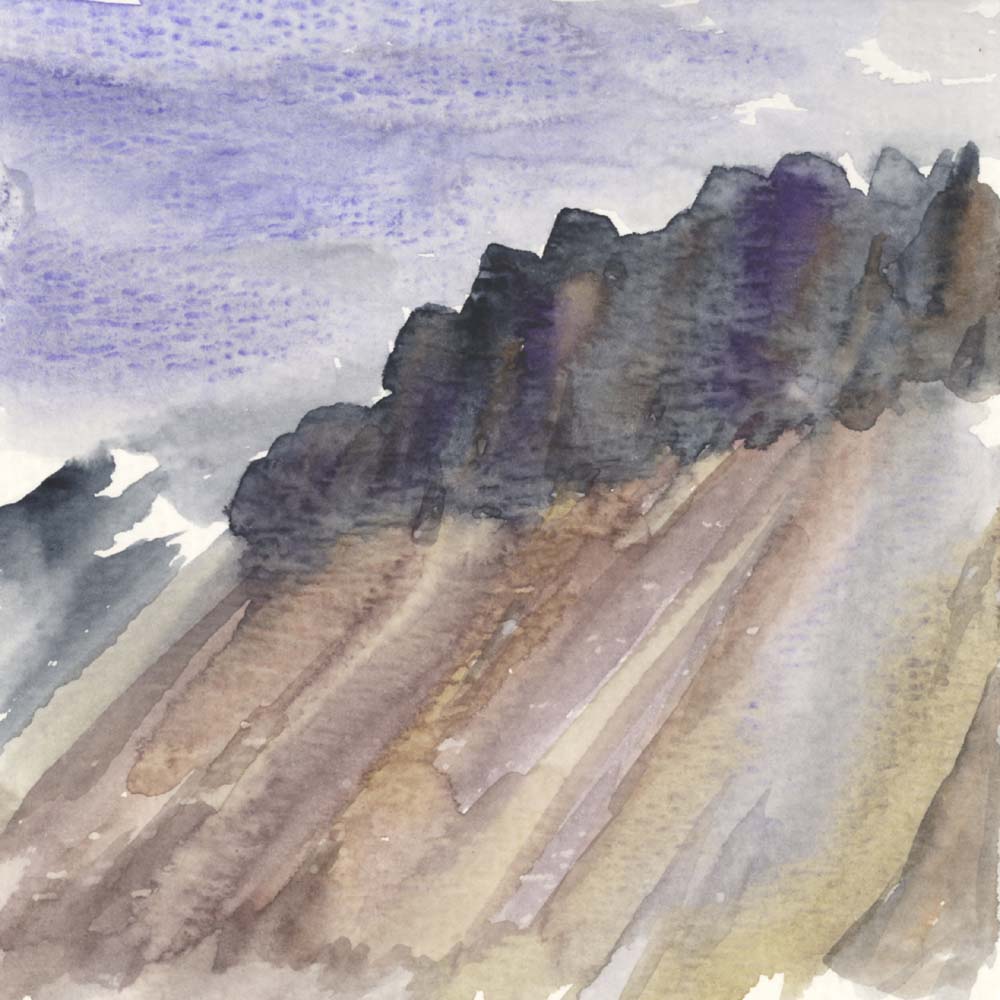
Valleys and mountains, both distant and close by. The snow has laid itself upon the peaks overnight. Perhaps it will melt in the sun, but I think it’s going to stay till the winter takes over.
From the shade of a tree not far from the river bank I draw the mountains, how the river is disappearing behind the gravel ridges and winding along the valley floor in a bed of grey granite rock that looks silvery in the sun.
Miraculously, I have got my Kullu cap back! The hotel owner in Kibber had submitted the cap to the Bodhi Guest House in Kibber where it was waiting for me. It is a beautiful cap, I am really happy about seeing it again. The happiness in Samsara.
The commerce is in full swing along the great bazar street in Kaza. There are lots of market stalls that sell clothes, axes and sickles, pictures of Dalai Lama (something that is unthinkable in Tibet), toys, make-up, and all kinds of shoes. Tourists gather around the German Bakery for coffee, espresso, wholemeal bread, peanut biscuits, muffins, yak cheese, and sandwiches. Festivities are announced by drums sounding everywhere in the village. I am watching the reception of a prominent dignitary in the yard outside the great monastery. Women dressed in traditional clothes together with school-children greet the visitor with drums. Eight o’clock in the evening the street market will close and everybody will head towards the musical event at the schoolyard where a dais is set up. Traditional folk dances from Tibet and Spiti took turns on the stage, which included a powerful performance done by children dressed in beautiful costumes and accompanied with lively music.
18th of August
The motorcycle has become a substitute for the horse in the modern romantic lore of freedom, mobility and speed. Men arrive into Kaza from the great expanses riding on their Royal Enfield, a classic thoroughbred with a deep pounding gait. They are sweaty wearing khaki dungarees soiled by sludgy mud. They will tend to their bikes by the edge of the pavement and have a glass of tea at the German Bakery. Surprisingly little baggage on the rack; presumably they are on a short detour from a base camp where their women stay behind preparing the food. They are the modern nomads and vagabonds.
Today I will try to get the inner line permit needed to reach down to Kinnaur since one portion of the road runs dangerously close to the China border or through contested areas – a reminiscence from the Chinese-Indian war of 1962.
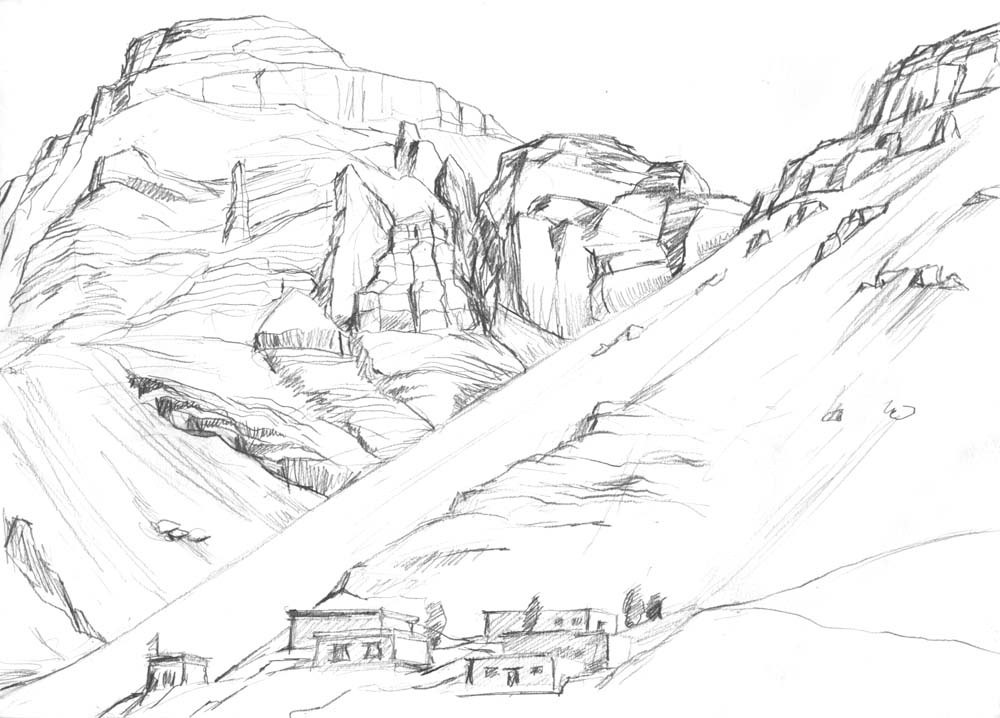
It’s a holiday today but there’s someone who is moonlighting at the Inner Line Office administrating passport information. It is a typical governmental office with dirty windows and a steel cabinet standing in a corner on the concrete floor. There are layers of dust covering the giant naked light bulb that is hanging from its twisted threads attached to the ceiling in a tangle of spider web. It was a time consuming process of registering into logs according to the bureaucratic setup. If one were to use computers for input of data at both ends of the road section and coordinate it, then one would achieve greater control. But now this work occupies an entire cadre of office staff. Just as well in this nation of unemployment.
There are more people at the bazar than yesterday. Business is good, people have money, they stop by, looking, discussing, examining, choosing, bargaining, buying. The women of Spiti are always beautifully dressed, slender and graceful, immensely attractive, sensual, aware, elegant, so much more than Western women with all their money. Here is a relaxed gracefulness without any noise. People stroll by, looking, buying, and moving on. Young people wearing Kullu caps are unusual; however it is often worn by elderly women and older distinguished strictly dressed gentlemen and in this area decorated with a beautiful green band.
Three nuns appear with their deep ruby gowns swept over their shaved head. Sometimes you’ll be able to notice the slightly pale hair line of the younger novices but the older nuns have skulls that are dark brown from the sun.
I’m having a cappuccino at the German Bakery listening to the buzz of voices. I will soon need a juicy novel to pass my time. I am nearly finished with the book I bought in Mussoorie.
I met a group of younger women on my way to the monastery. Their Hindi was about as stuttering as mine. They asked me candidly about what I was doing, if I was married and where I was heading. ´
“Oh, you are not married, why is that?”
“Unfortunately I have not yet met a woman I would like to marry.”
“But I’m available,” says one of them spontaneously, “take me with you, I can cook for you, wash your clothes and keep the house tidy.”
“Ah, but that would be very expensive for me. Everything in my country is very expensive. I wouldn’t be able to support you. When I’m old I will settle down in the Himalayas: Here everything is cheap.”
“Yes, come to Kaza, settle down here!”
“I like Spiti, beautiful mountains, nice people. I will likely return. Maybe I will marry someone here, perhaps one of you.”
Some police constables pass by swinging their lathis, rods of hard wood that are shorter than walking sticks.
I can feel that eternal tranquillity, the eternal being, the eternal now. The thing with nothing to yearn for, here everything is fulfilled.
The women carry their youngest on their back wrapped in a shawl with only the tiny head and legs visible outside the bundle.
A small boy beside me receives a chocolate cake from his mother. He devours it to the last crumb.
Some tourists look repugnant, badly dressed with a bad posture and harsh facial expression, often overweight. Of course I am not like that, or so I’d like to think.
The roofs are covered with straw bales and colourful prayer flags that sway in the wind. The cows have their stall at the side of the house or indoors on the bottom floor. The walls are still made out of stamped clay done by gradually moving a piece of a wooden profile. They say that soil provides better protection against the cold than concrete. I can see how they are improving the outer layer of clay with an additional layer of cement mortar. The flat roof is supported by one or two thick bearing wooden beams that are crossed with thinner sticks, all of which is covered with a fine layer of twigs. Nowadays a plastic canvas is also laid on top of that before the outer layer of thoroughly stamped clay comes on serving as the finish of the roof. Climate change brings more rain over the Spiti valley which is eroding the houses forcing many builders to deviate from the old construction methods. Casting a concrete roof is a large enterprise that will keep some twenty people busy for more than fourteen hours with cement tumblers and lifts, not to mention the supporting casting profile made of plywood that takes weeks to make. It is easy to understand why only a few can afford the traditional way of building but sadly enough, this often done by using the low wage workforce – poor people from the plains.
The sun has sunk behind the mountains, only fluffy fringes of clouds flare in the twilight and the birds are performing a lively concert. The town square is coming alive into a frantic activity. All the restaurants are occupied by Spiti citizens and middle class Indian tourists. Life is excitement and party, everybody is off to the music event wearing mobile phones and involved in energetic conversations.

19th of August
I’ll stay three nights in Kaza and spend a few days in Tabo before Kinnaur, and there’s going to be an excursion to Dankar tomorrow.
It’s a chilly morning. The market stalls are set up before the last day of the festivities. Clouds hide the sun which explains the cold air.
A tractor is slowly rolling through the village road pulling a trailer for garbage. People are allowed to throw away their waste unsorted directly into it. Perhaps it is sorted later by cheap labourers at the dump.
Sexuality is pushing on, desire for union, penetration, ejaculation. What is love, I ask myself. It does not demand sex, it is outside of carnal needs, it does not look for what’s mine, it is happy to be what it is, infinite love of life, the colours, shapes, and the experience of the now. I need that qualification. What is the objective of love? It is found in the wind’s grip about the treetops, around the poor emaciated woman with the small child that needed food. The child was terribly thin, a girl that is worth less in this country, perhaps she won’t survive. Have they taken advantage over her? Is the money handed over to her alcoholic husband? Do we really know what is going on in the world, the truth about humanity?
The rain is coming in small gusts and I wonder about the trip to Dankar tomorrow. The street merchants are covering their stalls and some are already beginning to pack up. It’s the last day of the festival. Groups of people are moving towards the ceremonial site in the late afternoon for the closing event.
I am painting the valley and the mountain on the other side in water colour. Wide awake attentiveness now. Having no pre-judgemental beliefs about humanity and nature I try to see things as they are.
The Spiti villagers have no particular casting system but there is a subclass formation happening that is exploiting people for construction work and household chores. It is tragic to see the patterns repeat. These people live in dens, damaged tents along the town limits where the smoke is rising from primitive wood fuelled stoves. They leave their excrements in the surrounding along with the stench that follows. The Spiti townsfolk use lavatories, and where the waste water ends up I have no idea. This is India with its recurring issues. It is a striking fact that this thriving area has more beggars than my home town Mussoori which is located on the verge of the plains.
What will I make of this journey? The journey itself is said to be the goal, and I agree. There is no other meaning to seeing this sharply drawn bare landscape, the colours over there in ochre, green and blue tones, beautiful people beautifully dressed, the noise from children playing and holy monks floating by muttering their mantras.
Wishes shall cease, yearning shall cease, worries and anxiety do not belong here. My heart is reminding me of the pulse inside, the elementary air, water and bread. The wind hears my thoughts. Whatever is written here will sooner or later turn into dust. The writings, the drawings, the colours and shapes bear witness of my activity, that which is my steady companion, motion. When movement ceases, I will cease to exist leaving only prints in the sand that is going to wither away. According to cosmological theories on time and space, every moment is recorded somewhere, but it is not a book one can browse.
The rain has stopped and the sun displays its last rays. A couple of women are setting up their market stall once again and have a cup of tea in the afternoon light amid a peaceful buzz that is colouring the air.
I write only for my heart, that I may find peace to live with the heart, with inner tranquillity and outward attentiveness, freed from judgement. What do I know? Nothing really; I’m listening, learning, watching, trying to understand. My own ego-centricity is obvious for everything is passing through me, conveyed by me, generating something new or remaining the same. I am a pulsating heart, receiving, emanating, tinted by my character. Man’s magnificence and insignificance. I cannot fathom the dimensions of space. I see the stars upon the heavens, perceiving all, still I am nothing.

20th – 21st of August
I am going to Dankar, the former capital of Spiti. A proposed day’s excursion turned into two days with a stay overnight. Stepped aboard the early bus to Tabo to get off where a trail is leading up to Dankar Gompa through at steep ravine. At the highest point it clung like recluse monastery with adjacent caves for meditation and solitude. The thousand year old building, placed upon pointed cliffs that have withstood the erosion of time, rose like it was an integral part of mountain itself. What would pass for monastery, or rock, could sometimes be difficult to say. The prayer rooms and holy chambers of the monastery have become too small forcing the monks to build more on the other side of the ravine. There was an atmosphere of mysticism in the old temple, which was erected with several floors and narrow winding trails that followed the structure of the mountains upwards. Inside a small chamber it was possible to get a glimpse of a few chortens at the far end where the ceiling was too low. Perhaps they were built at a time prior to being enclosed inside the monastery. Above the monastery at the topmost level the old village lay well protected by surrounding mountain ridges. The new village has been spread over the eroded precipices that fill the upper section of the ravine. At its highest point there are the leftovers from the erosion, a forest of statues and pillars, suggestive of being civilisation remnants with standing sarcophaguses containing mummified giants.
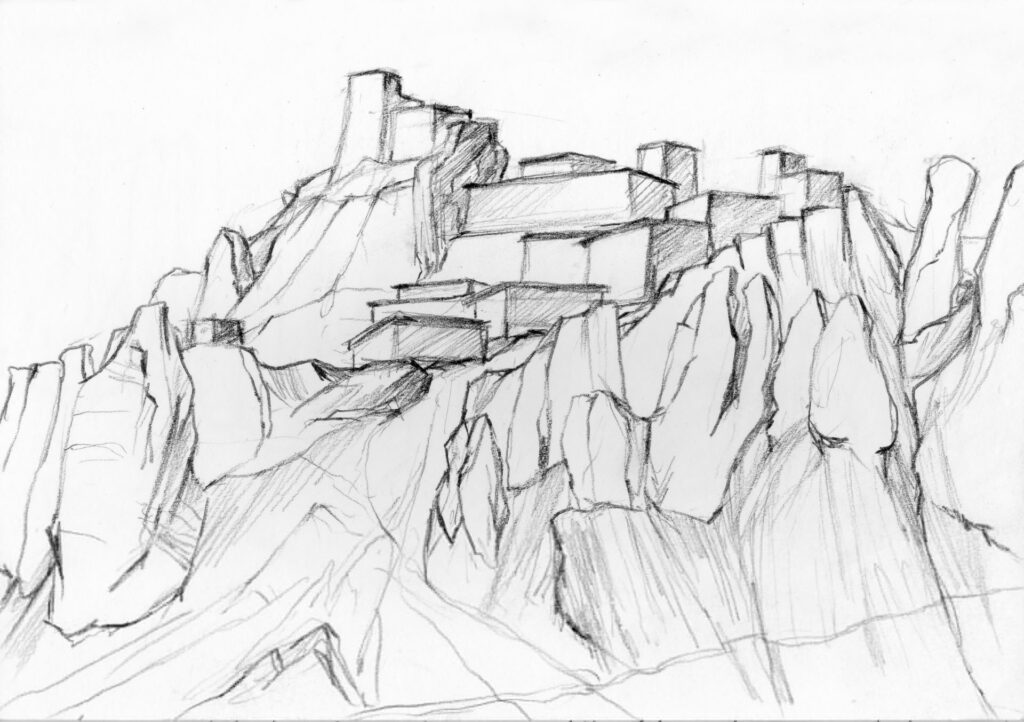
An elderly villager escorted me up to Dankar through the ravine. We had a break by a ridge from which the monastery and the statues dramatically stretched upwards. I served water and biscuits which he received with gratitude while we chatted about the recluse caves that could be seen at low altitude in the steep mountain wall. A long time had passed since the last time anyone meditated there. Later he invited me to visit his big house. It had a large central kitchen inside of which he served tea with milk and lots of sugar. You take your shoes off at the entrance and sit on a rug with a low table in front of you. Everything was simple, neat and tidy. There was a solar panel on the roof that could supply rechargeable batteries for the few lamps that were installed. They had built extra rooms on the roof using the old method of densely stamped clay. Heaps of hay spread over the entire roof will secure the winter supply of fodder for the cows. a calf, the sheep and a few goats staying in stables beside the house or at the bottom floor.
During the evening hours hordes of sheep and goats returned from the grazing tour up in the mountains. With constant bloating all of them flowed down to their specific households without any intervention from their owners. Next morning the opposite happened with sheep and goats at first coming in small groups to the gathering area from where they streamed across a small pass and disappeared with the shepherd to the pastures in the mountains.
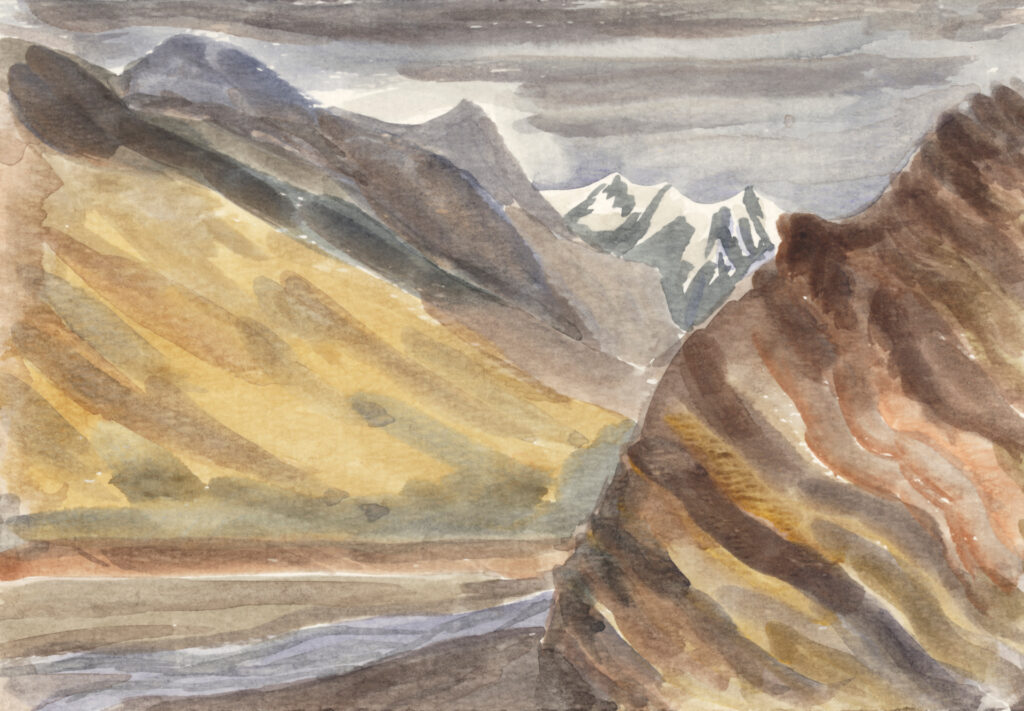
The trail that went to the lake was steep and difficult. But it was worth the effort to be able to see the view over the harsh and aggressive shape of the Himalayas. Up here the mountain had flattened out into smooth hills overgrown with low bush that provided excellent feed for sheep. Right across the river one could get a glimpse of the entrance to Pin Valley where the snow leopard and ibex wander in the arid and barren landscape. There is a breathtakingly beautiful walking trail over the high passes between Pin Valley and the Kullu valley.
The lake is located inside a basin high up at 4 500 metres of altitude and supplied by water coming from a small brook. It is shaped like a half-moon just like the Manusorova Lake at the holy mountain of Kailash in Tibet. All such lakes are sacred for Buddhists and that is marked by a chorten that has many prayer flags. I was alone by the lake with the mighty Himalayas as a panoramic backdrop. The lake was teeming with life, presumably implanted fish that had grown really big, about half a metre. There was something wild and unpredictable about the lake. I imagined that the fish would continue growing, developing feet and becoming giant lizards terrorizing the villages nearby. I had read something like that in a science fiction novel.
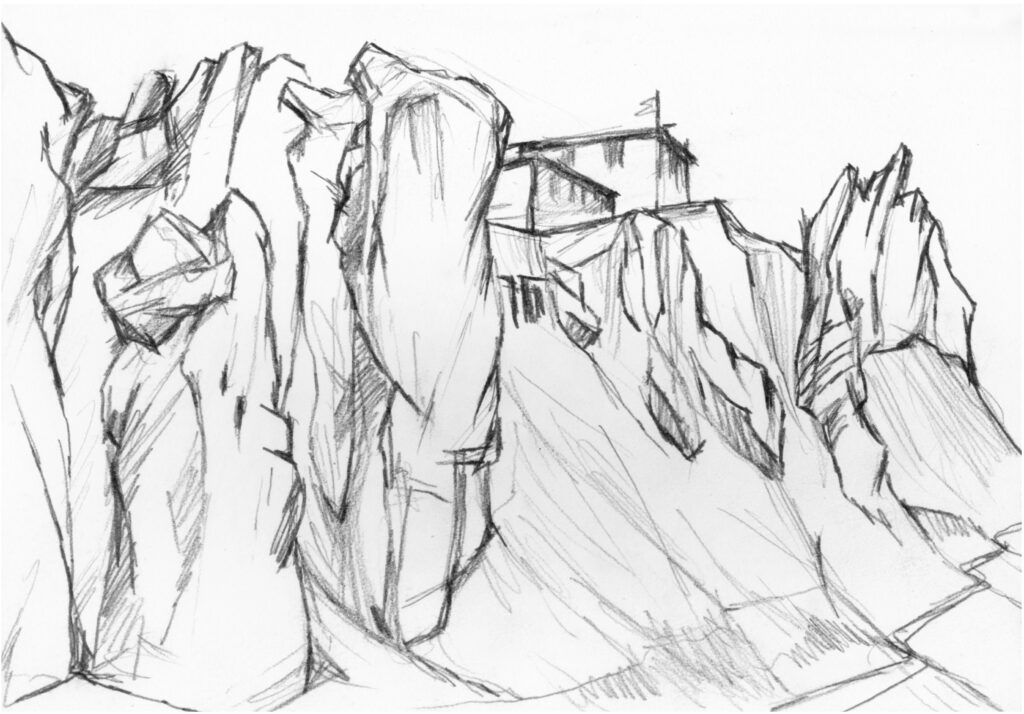
The sun had set and only the peaks were glowing. Red clouds were still illuminating the valley during my walk down to Dankar.
The life of a recluse in a cave or a monastery or the solitaire who spends years of meditation in a cave is difficult to comprehend. Water and food have to be carried to the place where he is sitting in the yoga position. Is there any wisdom to this? The initiation for becoming a llama requires three years of meditation. Insights are achieved as well as purification through self-denial and discrimination, a well-balanced diet and a well-balanced way of living. These are things that are so much more desirous when you’re getting old. There is joy and beauty in life as it is, in the small, simple and uncomplicated.
During my climb down the ravine to the road where I would catch the bus to Kaza, I saw three small children on the way to their parents. The smallest girl was crying so violently that snivel and tears blended. Her elder brother carried her on his back. They wouldn’t say anything to me when I asked if they needed help. It’s hard to get a reply whenever fear and insecurity rules. Where is the beauty of life for these children when living means suffering, perhaps with some bright moments of food, warmth and sleep? I noticed the determined facial expression of the boy not to ask a stranger for help when he resolutely took the little one on his back. I could hear her crying in the distance when I had reached far down into the valley. Some people were working in the fields, perhaps it was the parents. Such things linger on, the children, exposure, abandonment, fear.

22nd of August
The journey to Tabo. I had a seat that I later on offered an Israeli man who were travellin is g all the way to Kinnaur. I saw remarkable mountain shapes on both sides of the road. The withering due to erosion happens in several stages. The steep original downhill collapse is being condensed into a solid mix of gravel rock and clay, which in turn withers down due to ice formations and temperature shifts, and forms statues and pillars each shaped like a sarcophagus. Occasional pillars may have a big rock poised on top like a capital on a column. There are endless pillar halls measuring from a few decimetres up to several metres in diameter. Impossible pointing elongated cubes extend from the mountain wall with small cone shaped towers on top like a slightly eroded piece of architecture from ancient times. Hermit caves can be spotted high up on naturally rounded pilasters of enormous size. The hermit had to lift food and drink using a rope. How did he get there in the first place? Further down towards the river, sand and layers of clay are exposed which have deposited for thousands of years. They shine yellow-white along the river banks, sculpted like sugar cones.
The plains below the mountain are strewn with boulders of all sizes. How frequently will a large boulder come off and roll down to the plain? Does it happen once in a decade or once in a hundred years? The perspective is staggering even for such small events.
I am catching my breath in the restaurant at the hotel roof. The young boy who serve as waiter seems a bit awkward and doesn’t know how to perform his work and take orders, but he seems in full control over what’s on the menu which after a while shrinks down to just a few dishes.
On the one side the mountain is rising steeply from the flat valley that is left by the river sediment. The other side is dominated by several generations of scree. It feels as if Tabo is located at a lower altitude than Kaza for the air is slightly warmer.
Life is body and soul in beautiful union. You need to experience the body in all its parts. Thought are streaming from inside. The brain is working frantically trying to bring order to existence. The brain is capable of suppressing bodily needs like sex, hunger and social interaction but it’s not that easy with water and oxygen. You won’t die from sensations of hunger; you die from food deprivation when you don’t feel hungry which is more dangerous. A little something to eat every four to five hours is completely fine. I exercise three times a day with stretching, work on back muscles, and abdomen also. Despite this regimen I often have back problems during prolonged walks carrying my backpack.
The sun pours down over Tabo and the unique monastery which is wholly built in wood and clay with no windows. I bring a sketch pad along since photography of the famous paintings inside is prohibited. From the outside it looks like mysterious heaps of earth, pyramid structures flanked by simple chortens. Its outer appearance is inconspicuous like that of simple clay huts but their size is astounding. The inside walls are covered with paintings in bright natural colours and a sparkling drawing of Buddha in all his incarnations, Jakata tales, flora, fauna, endless rows of Bodhisattvas, both male and female and even Hindu gods like Ganesha. The paintings have delightful details where the drawing is flexible and innovative. The colours sometimes are graduated creating three-dimensional effects. Tabo used to be a famous learning centre for many centuries with an impressive library. Today Tabo has been declared a world cultural heritage site in league with the most prominent monasteries in Tibet and is one of the oldest preserved Buddhist monasteries with uninterrupted traditions since 996 AD. It reminds me of those European monasteries that became the hub of advanced studies and preserved cultural traditions and a permanent centre for locals. I bought a treatise on the monastery. It had pictures that added profound insights into the iconography. Tabo also has a large convent school with classes in all subjects. Unfortunately the art class for tanka painting was closed during my visit there.
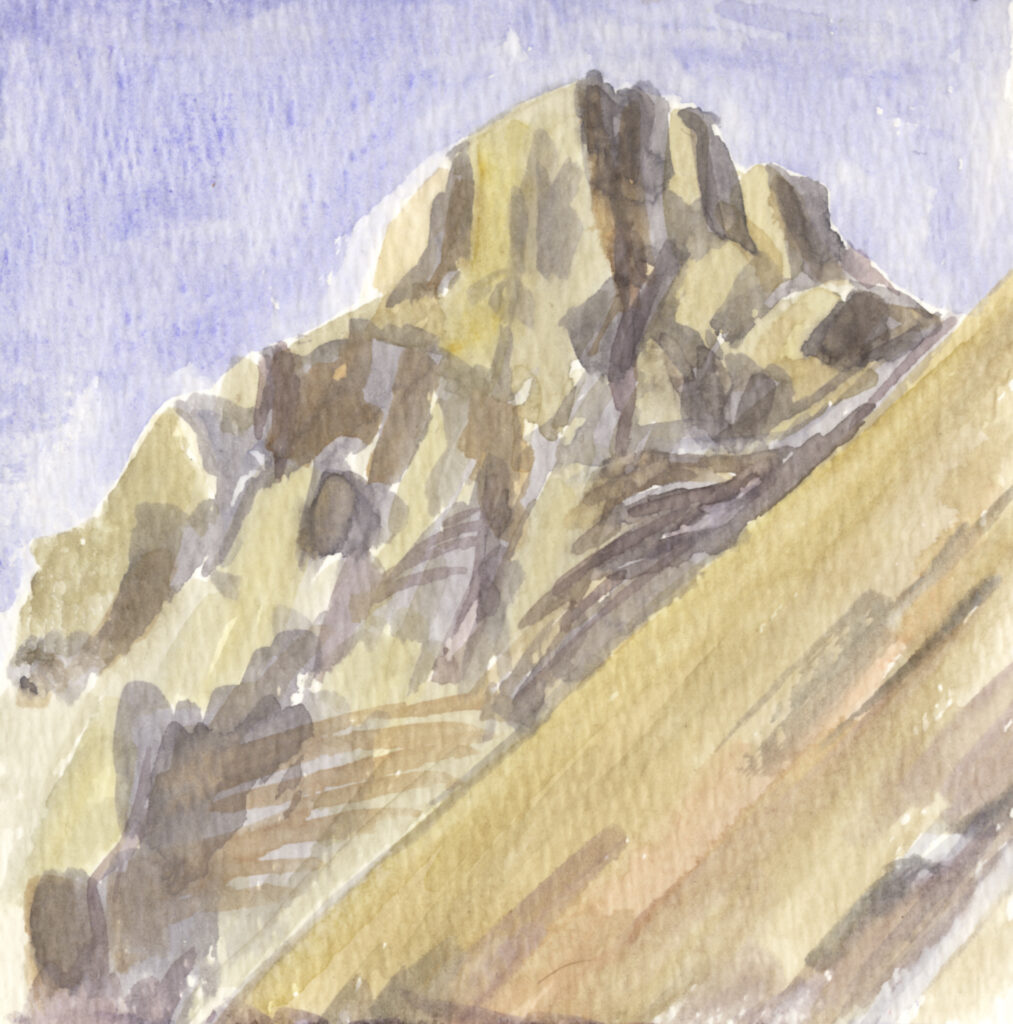
23rd of August
Writing is an act of remembering like writing down the story of all my love affairs. What would have been different now should any one of them have produced a family, children, and children becoming adults, grandchildren? Would I have been sitting here now? Would I have been as much of a seeker, present, exposed, and reset as I am now? Would my past have meant more for my present situation? Would I have divorced my wife, would I have lost her? If I had no children, then perhaps I would have been sitting here. Life is bound together by relatives and duties. So much more difficult to break free then. Would I have been happier than I am now? What would the names of my daughters and sons have been, and with all their upbringing stored in my memory, would that have made me happier? I am just standing here in the now anyway, the past is gone, my memories are like memories of inert things that do not exist now, they are components of a living ever changing poetry.
I possess my own momentum and rest in my own intelligence. I can sense my own heartbeats and understand other people’s heartbeats and appreciate them. Some people talk in a sympathetic way but lack grace. Am I graceful? How can I make the world a more graceful place? Often I am grouchy, irritated, and suspicious and I lose my temper.
At the village centre I came upon a giant square complex that contained living quarters. It was a guesthouse for all wayfarers that came for the 1996 millennial celebration of the Tabo monastery and was also visited by Dalai Lama who performed a Kalachakra Initiation (8). It was already marked by the veneer of decay because of low expenditure and bad maintenance. The restaurant was out of order and there were heaps of rubbish everywhere just as if it were ready to be taken down. There is a large yard inside and extensions on the second floor that have skylights, all constructed in the traditional Tibetan style.
The poor subclasses from the plain-lands are exploited here too. Everybody is keeping servants from UP and Bihar which are the regions below the Himalayas
Like leaves in the wind, such is the children’s play in the yard by the house, constantly moving, laughing, yelling.
In the distance against the grey-blue sky the snowy mountains are lit by the sun. I am going to paint using water colours tomorrow. I’ll move on to Kinnaur next after a couple of days.
What is work, really? A forced flow of thoughts, keeping a thought for a while analysing it to see if there are other sides to it, other views? What would I rather work with? Is vacation also the absence of work? Those who work have an identity, like a carpenter’s pride over his work, the construction worker’s satisfaction when the house is completed, or the weaver’s care for teasing, spinning, dying, weaving, attaching pieces together and sewing. While working everybody is at peace. Life goes on and there is some kind of harmony.
None of these untrained young people one sees here wants to do traditional handicraft. They want to play with their mobile phones, ride around on their motorbikes, dress according to fashion, and spend their time in cafés in the company of a deck of cards and beer bottles.
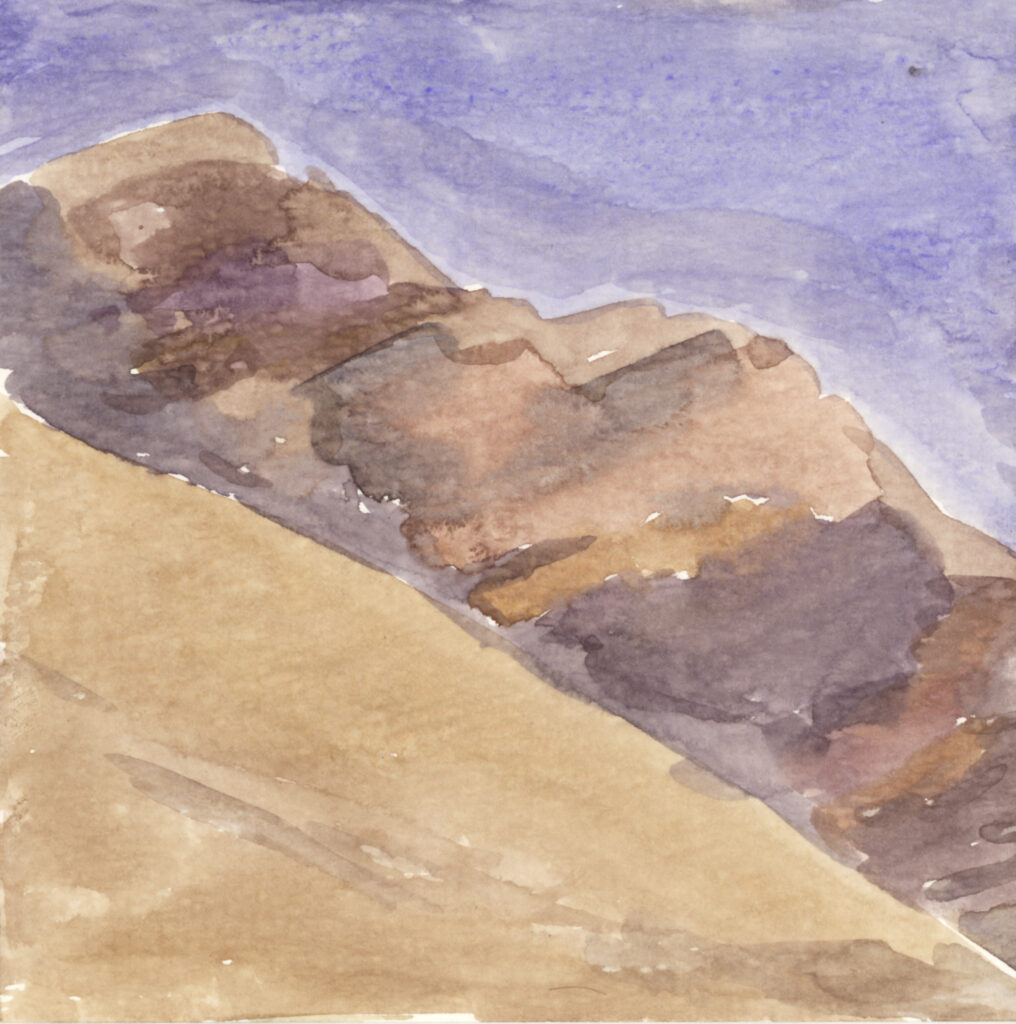
I communicate with myself, between brain and heart, all limbs and senses, all sensory impressions come to me. People don’t seem to communicate with each other in any real sense. An American citizen whom I spoke to was engaged in a conversation with himself. One company with a domineering spokesperson shouted commands. The talking reached a level of frustrating energy. Wrapped up in alcoholic fog they spoke in unison using the language of Spiti, unintelligible to me, in high pitched voices. No matter what language people use one can always, from the voices alone, detect whether the conversation is joyous, fun, exciting, or aggressive. Finally I left with booming ears.
Listening and watching, silence is golden. The dialogue with myself starts in the silence of my room lit by the lamp. Tranquillity comes from within and brings with it the perpetual transparency before what is happening. Can I hear the misery, can I see it, or hear the tales of violence and conflict? Am I retaining my own peace of mind, am I processing all the impressions before I convey opinions like politics or ideologies? Listen to approaches, tone of voice, listen to the silence and notice all the small words, those that are simple, and value laden. The repetitive jargon is an expression of insecurity.
Stories, I am not a good storyteller because stories don’t seem to stick with me. Stories in illustrated form that are translated to text require practice. My own story needs to have an impact also upon myself, even though I am familiar with how stories start and how they end. In that there lies the quality test of the narrative. I too must be able to enjoy the flow of events in the story.
Imagine there are designers, hundreds of them, sitting nearby. Would my drawings change, be different, lose their worth? My drawings are done from a point of attention, my individual point of view like the angle of a photography, what is imprinted and what isn’t.
I am hot as usual, fantasizing about women I see, what they are going to be like naked, their breasts, hips, their legs, shoulders and their neck. Why this obsession? When am I going to see the human being instead of potential sex? Man will probably never relieve himself from it completely. Impressions trickle down to the member which will assume an erect position. Dependency, desire, drive? Heart and brain, upon closer inspection, this will pass; it’s the distance that is fuelling fantasies. I am hot for woman, the women that I have loved.
The mountains are far away, the light that creates different shapes form ravines and ridges. At times, the mountain are flattened out, at other times they are dramatically sculptural.
I feel reset back to zero. Should I remain here for a while or get going? Fantasizing about new territories, it’s probably raining in Kinnaur, and here the weather is drier and sunnier. That trip is going to be tough and I am awaiting the right day and time.
Leaving Spiti has a nostalgic feeling to it; it is like a Tibet in miniscule form. I will return to Spiti, I hope, in the company of a dear friend. Travelling alone like this won’t do in the long run. Perhaps that’s why I never set off to India between 1987 and 2000; I had no one with me. In the end, I went for a tour in South India. My thoughts were written down in solitude. That trip was poorly documented, now I just have some pictures and an unfinished text. The trip of 2004 went to the mist shrouded peaks of the Himalayas. My trips in 2008 and 2010 were all lonely with the diary as my sole mate. Only sporadically do I find other tourists to converse with.
My own communication between heart and brain, between feeling and sense is what I return to no matter the quantity of company I have with friends, or sex with women. I will return the inner space where body, soul and spirit unite, where my intellect cooperates with my heart and all that is constantly emerging from inside. Solitude is a resort in every circumstance; it is sought. I will always take a walk out into nature. That is the only uniting factor that exists within me, India, Sweden, the Azores, Portugal, or Italy. Wind, water, rock, trees, grass, flowers; soon there’s autumn in Sweden and time for taking pictures of the season, smelling the earth and dry leaves, taking a ride on the boat to the archipelago, and look at the sea.
The wind is grabbing the long triangular prayer flags that are mounted on poles. They flutter like flames in the darkness when lit by the headlights from a car. Above me the Milky Way is seen sparklingly clear from the one horizon to the other.
When do I work? This writing seems like a pastime, the pastime of loneliness. Drawing and writing belong to solitude, like a mantra of life, the movements of hands above the surface, forming characters for someone to decipher.
The river, which has been accumulated from thousands of small and large sources, has gathered into fierce rapids beside the mountain. Mainly glacier water but also increasing rain creates new sources, and more so now than in the 60s and 70s when the land was known for its drought. Even Ladakh has been affected. Catastrophes happen during downpours when houses “melt” and are being flushed away. Strange fact that houses still are built using the hard stamped clay method. The walls are protected by cement stucco and the roof is insulated with canvas beneath the earth layer. Over there I see people watering their roof, presumably in order to prevent it from cracking up in the heat from the sun.
25th of August
Time to break up, there’s a time for everything. Three weeks left of my holiday. Will I have time to go to Kalpa, Singla, Sarahan, or Shimla? I could stay for three-four days in each place drawing, painting and writing with good accommodation, eating sensibly and taking long walks. I am going to miss these bare mountains with all their colours.

Kinnaur
I arrived in one piece in Kalpa. The road leading here was in a really bad condition. At the start the mountains were bare and the ravine was steep where the violent Sutlej river was meandering forth. The road was partially cut off very close to the rapids with the mountain hanging over the bus roof. Soon it was going to be impossible to drive down there and the bus struggled uphill through a serpentine road. The arid and barren landscape gradually shifted into forest clad slopes when we approached Rekong Peo. The trees held the steep downhill slopes together and the river deep below had carved a groove for itself. The difference in altitude from down the river bottom up to the snow-capped peaks was dramatic.
It’s nice to be back in the mid Himalayas. There is a strong dramatic atmosphere over the mountain at sunset. Here it is dark, the electricity is out and one prepares food in the kitchen using stoves that run on gas.
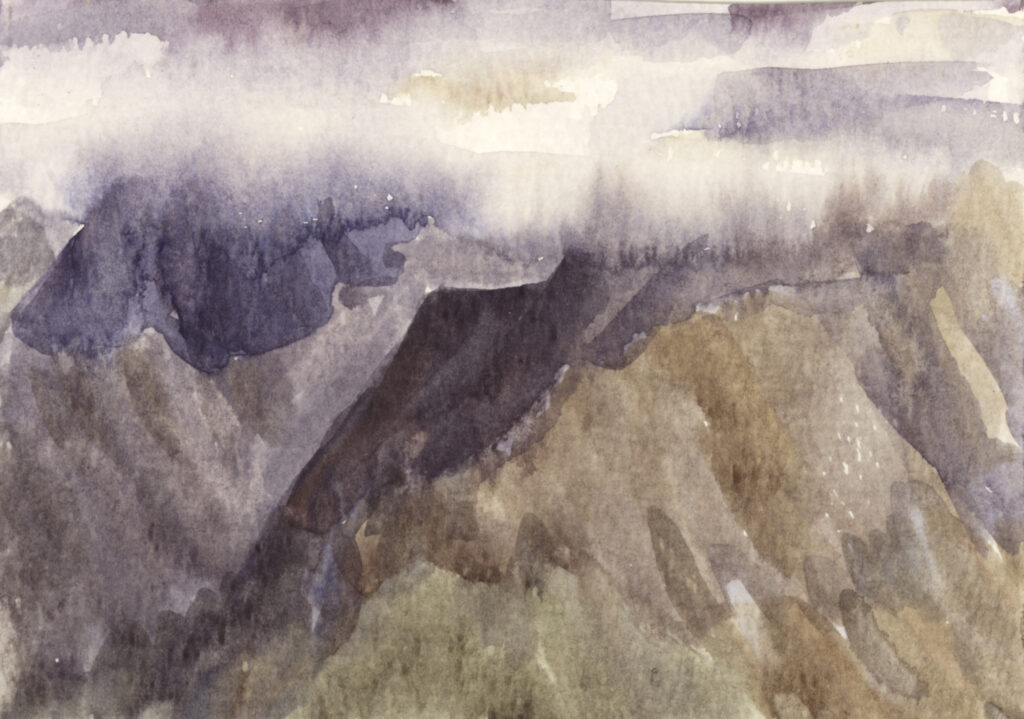
26th of August
Kalpa. Mist is obscuring the mountains for a short while until the Morning Prayer is finished in the temple up the hill. The choir singing that came from the loudspeakers sounded like tape recordings. A large chorten towered by the prayer hall where Buddhist flags waved in the wind. Its roof was a square in Chinese style with corners that were bent upwards.
I took a morning walk uphill between houses that had their roof covered with stone tiles. The apple and pear trees were heavy with fruit. The mist still lay around the mountain peaks. Further down towards the valley floor a thousand metres below the sight cleared against the villages and terraces that lined the river.
If I can afford it when I’m older, I am going to rent a cottage in the mountains with a view from a porch where I will be able to paint with water colours, take strolls into the forest, listen to the mountains, the wind and the rapids. Up here you won’t be able to hear the Sutlej River. Kalpa is located at a very high altitude with only small rippling streams for irrigation. Perhaps I can find a place like that here in Kinnaur. The Himalayas are so inconceivably huge.
Met a photographer who owned a shop beautifully positioned on the downhill towards the valley. Business had declined now when everybody had got mobiles with a camera. His income was sporadic and coming from taking wedding pictures and selling various trinkets. I was invited to his house where his mother served tea. His parents’ home was an incredibly charming and rustic construction that was fitted with old furniture and handicraft. His study was crammed with goods that were for sale. In one corner there was a laptop that had internet connection from which he were exploiting new methods of developing his business. His greed sparked an increasingly optimistic view of future prospects with all the information and knowledge I had to offer. However, I did not promise anything, and I was quite relieved about not having anything to do with him in the future. He will be doing fine.

A woman is sitting beside me at the common gathering place of all Westerners at the hotel terrace. I am yearning to be with a woman, and she does not seem to have suffered from a shortage of lovers. She is graceful, determined and secure inside. I feel jealous of all her previous lovers. Now she is sitting next to me, now she is gone. She is a nice woman but the sensation is over and I am no longer interested in her.
Layers of clouds are being ignited by the evening sun. The evening prayer has just begun in the Buddhist temple. The small child tries to eat supper consisting of boiled vegetables that slip off the fingers and fall down to the floor. One nonconformist couple from Israel have brought an energetic two year old son along. He is talking a lot for his age, both English, Hebrew and fragments of Hindi that he’s been picking along the trip. Since he was dressed up with a skirt on top of his pants and had his hair done with a ponytail I took him for a girl before his parents corrected me. By bringing small children along while travelling to India one is initiating connections to the surrounding people. Indians love their children and want to be close to them.
Would I be able to have kids? Not in my years, for soon enough the children of my siblings will come and I will be grandmother’s brother or grandfather’s brother to them. My genes are not going to be transferred further. I cannot accept to beget life that is as problematic as mine. You’re supposed to stay with your child until it has grown up. Liberation will come gradually though independence achieved by confrontation. It is a strange bond, undelivered by separation from the parents during the school years. We were so anxious not to hurt our parents that we couldn’t even gradually start arguing with them and their completely idealised position on the Christian way of raising children, faith and morals. And then losing touch with their children, sending them to boarding schools yet thinking we would still share a common belief system. Their sense of humanitarianism is present there, like love and being good role models, but there is also fundamentalism and sectarianism. They were not capable of seeing it, because it was the sole basis for their existence, them or us, the unfaithful pagans and the saved ones; but what about all the others? Wouldn’t education suffice?
I walked upwards between the stone walls, upwards and upwards. The apple trees on the terraces are abundant with fruit with an occasional pear tree. There was apricot of some dwarf species that resembled wild apples. Perhaps the climate is too harsh here where even peaches look like small green furry balls. Everywhere the sound of irrigation canals. The sun began to set behind the mountain and the forest darkened. Some solitary half-finished cottages of stone and clay could be glimpsed among the trees. Cow dung indicated herding of cattle on the way to the pastures. I had been walking for three hours uphill but I had several hours left before reaching the summit. As luck would have it, the way back downhill was a lot faster to walk before everything was left into total darkness.
The Israeli woman is very attractive. A friend of her who came behind is now joining her. Soon there is going to be an entire colony of Israelis here. The Palestinian conundrum will be a recurring conversation topic which is an extremely complicated question about occupation, settlements, the one or two state solution, conflict, war and terrorism. They don’t like the government’s policy and their protests are fierce. The recent wave of democratic liberation in the Arab world is of course not relevant to Israel. They protest for other reasons, and the Palestinians have always been struggling for freedom. All these roaming Israelis on their way to India or South East Asia form the new Diaspora, escaping from a nation of terror behind a bulwark.
We always seek the natural, the intimacy with what we really are, an expression of nature. We want to be something more but we are not. Culture is a natural process, a development according to intellectual capability. Many remarkable natural phenomena are more complex, more absurd, crafty, and more inventive than things that the human intellect ever have come up with. We have our own unique language which is one language among other languages found in nature, nothing more. Everything hinges upon survival. The core of man’s survival strategy is over-exploitation which is a flaw of reason based upon ignorance, greed and fear. Fear that nature isn’t doing what it is supposed to do, fear that the supply won’t be enough. Man is the most weary creature in nature caused by his unrestricted intellect, his belief that he can do whatever he wants. He must at all times learn from nature and experience. Nothing is predetermined in his mind or pre-programmed into his genes.
The sun is pouring down at noon; even here in Kalpa it burns like gas torch. The fragrance emitted by the forest and the plants is intense. It’s not just apples, pears or apricots that smell. Spicy odours from herbs and flowers rise from the soil. The conifer fragrance is rich with turpentine and resin.
Heidegger
Being, being and forgetfulness, we forget being just to be able to remember. We think we know what is. That which is close up, is; and that which is far away in the world, is. Existence in the world, being in the world; we are present in the world. We exist in language. What is being? Is being in the world a space of possibility?
Man inside the world, being born into it, drawn into it, stuck in it, thrown into the world, granted to the world. While being in the world, we are in a way tuned into a mood that is given to the world and exists in the world, and exists within me. We see and discover new things, but are we really free?
Fear and anxiety!
Fear provides a contrast to anxiety. Anxiety comes from not being in the world. Not being able to comprehend the world elicits questions about being and the relation to non-being. That might possibly yield a tranquilized philosophical mood. Being and Nothingness are opposites like light-dark, active, passive, and so on. Since we exist in the possibility of being we are also everything that we are not.
Existence is going somewhere. There is a causal connection. A faulty plough means not being able to till, not being able to sow, it means no harvest, no flour and no bread. The connections are equal to ‘is’. Are such connections meaningful?
How does Being appear in the world and making the world appear? Existences, in the name of true or false and obscure, gives rise to moral philosophy.
The meaning of Being. How does Being appear? Is time the meaning of Being? Does one at all understand Heidegger?
Words as reality – the reality behind words.
I am inside my body. I am sitting in the chair with my internal organs, my bowls, my heart, my lungs. I am inside my thoughts about existence, my sensory impressions are like the mountains, the peaks that disappear behind clouds, the houses that are anchored into the rock, the trees that carry fruit. Life within myself as a security, heart and brain. Worrying about the future, why? Living in the now, the horizon of infinite existence, in the now. Submerged into the now, into that which is the great ocean, eternity.
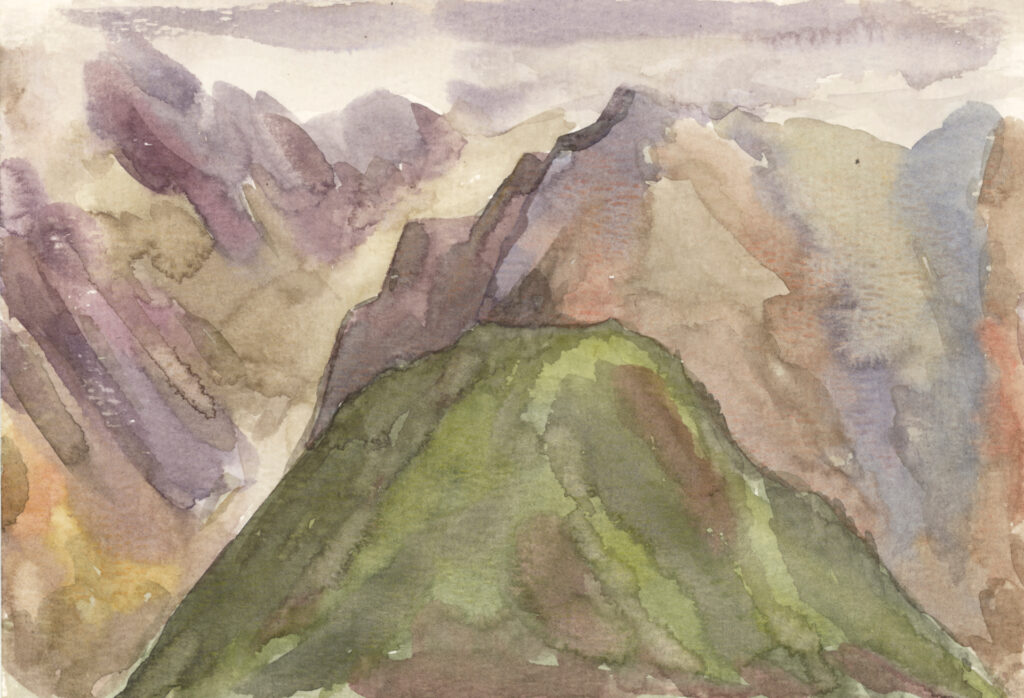
I walked towards the west and followed the road beyond Kalpa until the landscape became like a dream. The road cut sharply into the mountain that fell steep like a precipice down to the valley floor with its gushing river. Sparsely distributed knotty coniferous trees grew on the naked cliffs like a contrived Japanese garden. Water poured forth from the stream that ran over the road and the fragrance of conifer and resin was intense. On the far side of the valley lay a village on top of a three hundred meters high vertical cliff. Further up towards the west there was terrace cultivation and an undulating landscape that floated in the evening sunlight. A few houses clung along the precipices towards the river.
The woman fancied me but I did not respond immediately. I have a feeling that she doesn’t like India, and our interface sort of disintegrated. She is on her way to Chitkul which is I were I’m going later, but shall we go together? Here things are fantastic as they are; man always wants to go further, inspect new territories and discover new landscapes. Are we never happy about where we are? It is fantastic here, high up with views both upwards and downwards; one is located somewhere between heaven and Earth. Clouds will seldom go down into the valley, they will float about the tree line obscuring the peaks.
Nothing else apart from what can reach me, within me are memories, from the outside come movements; is that reality? The living pulsating heart from within and impressions from the outside revive my memories. Soon external matters will live through me, everything is revived in me.
Food seems to be something that Indians go for with determination. The don’t seem to pause at all during a meal and the never talk when they eat. They eat the food quickly in silence and once the meal is finished, one leaves. They are the ideal customers for fast food chains. Getting together for a cup of tea is more like the occasion for conversation and one may be sitting there for hours!
The woman next to me is seeing her friend and they are fully engaged in a conversation. I miss a good friend with whom I can talk freely. I always talk to strangers. When do you become a dear friend to someone? It is mutual but one communicates on different levels. Perhaps candidness will increase whenever a good bye lies close at hand, and one lets every thought loose into space making a print in time that won’t recur.
The woman is sitting comfortably beside me. She is young with nice complexion, her legs are beautifully sculpted, her breasts are clearly discernible, her belly is smooth and her booty is shapely. All of me is yearning for this but it passes by. I feel too old; she could have been my daughter. Cannot know how she is feeling, cannot understand what I am looking like through her eyes, being wrinkly and elderly. A hard on I get nonetheless.
I feel old before all these young women without any husband. What do I want, what are my wishes, what are my desires? I feel like I want to do some creative work, getting things done, doing research, examining things but I also want some spontaneous play. Life is about going from place to place anyway, spending some time on the Earth, leaving, abandoning, meeting again, and forming new acquaintances. No place superior to any other, no place more insignificant in the endless array of impressions that stir the juices of life.
29th of August
The small child is constant exploring existence, the nature of things, the nature of stone and sand, the water and the air, the richness of spontaneous life expressions. If every child possessed this freedom and possibility, the world would look different.
The mountains on the other side are displaying their full height. By comparison, and from this point at 2 000 metres of altitude, the peaks of Kinnaur Kailash and Jokandar stand 4 000 metres further up.
The Israeli girls left Kalpa today to go up to Chitkul by bus. The family with the little boy also left to go the other way up to Spiti. They took some tips from me about some sites worth visiting. I am saying goodbye to Pele, the lively boy about two, who has an intensity that I seldom see. There’s going to be something marvellous about him and one can hope that his parents will stick together. Melancholy takes over with separations like this one. I should have followed the girls to Chitkul, I would have gone there later anyway but I felt there was more to do here, drawing the ravine, the precipices and experiencing the magnificence of the mountains. My resolve to spend at least four to five days at each location got the upper hand. We are all out on our own trip but sometimes circumstance may offset one’s plans. The girls were so young and charming but I have no illusions and don’t make any approaches.
I am alone with the mountains again but I will be seeing people in Chitkul, Shimla and Mussoorie.
The evening prayer sounds again, it’ a pre-recorded choir that sings. The late afternoon sun dimly lights up the snow-capped peaks against a deep blue sky with a billowing veil of clouds that passes by just above the treeline. The valley lies in complete darkness.
Next morning I walked along the ravine. It was hard to find places to sit that was suitable for drawing, which didn’t give me either a stiff neck or made me dizzy. I drew the village that was poised on the edge of the cliff right across the river. The gusty wind did what it could produce a failed drawing but the evening sun put contrast to the mountains. I had everything imaginable on my mind, sex with women, loneliness, sorrows and the relation to the Israelis that had left. I regained my calm on the way back in the twilight with all its fragrances from the apple trees, apricots and peaches.
30th of August
I can feel the loneliness. It is raining today. Am I reading the signs alright, can I detect those small indications? Did she fancy me? I have realised now, after the event, that I am interested in her. I miss the enthusiasm and spontaneity of young people. Suddenly she wanted to come to Mussoorie and fancied seeing me, which was a surprise. It was already too late. Good bye and I hope I’ll see you again, perhaps already today. We could see each other in Chitkul; is there more going on between us than just a little attraction.
The journey to Chitkul took us through the narrowly wedged valley on a road that was cut into the rock just above the surface of a dam that supplied water for a power plant. Soon we entered the Singla valley and the climb up to 3 500 meters of altitude to Chitkul started. Chitkul looks like a village in the alps posited in a lush valley with an effervescent glacial river.
Why haven’t I learnt how to read and write in Hindi? Why, for example, didn’t I stay in India after 1987 to study? Was it lack of connections, fear, too much pondering about the meaning of life, or lack of funding? Would my artistic career have been more solid, and not torn into fragments like it is now? What kind of identity would I have acquired in terms of depth and feeling? I feel split still, as if I have missed out on a part of my own history, but history can take an infinite number of different routes with different blows and development lines. Like teaching Art in India, for I didn’t want to go back to my Swedish career of odd jobs. Listening to people, to music, looking at art, drawing and painting. I have reached mature age, as they say, but I don’t feel any more mature now than I did before. The questionable validity of second thoughts; I have the history that I have.
What does it mean to be erudite, what is knowledge? There are no limits to what there is to know, but understanding is another cup of tea entirely.
There’s always talk about alcohol whenever people drink together in a group. I’m not sure about the reason for this but the subject seems inexhaustible, how one manages, how much one drinks, what one drinks, and what the country specific problems are like. It’s a treacherous culture where addiction patterns develop quickly. They served apple wine that looked more like a distilled drink. If I would have that every day, the my desire for alcohol would return to me. Alcohol is not prohibited in Buddhism or Hinduism. I seldom drink when I am in India even though it is easy to come across whisky and beer. The country has no tradition of social drinking and there are no pubs or local bars. Alcohol is prone to creating problems and Indians in general don’t seem to manage it very well. Those that I’ve met drunk have been knocked out of their mind and that is immensely tragic. Therefore I drink very little alcohol when I am in India.
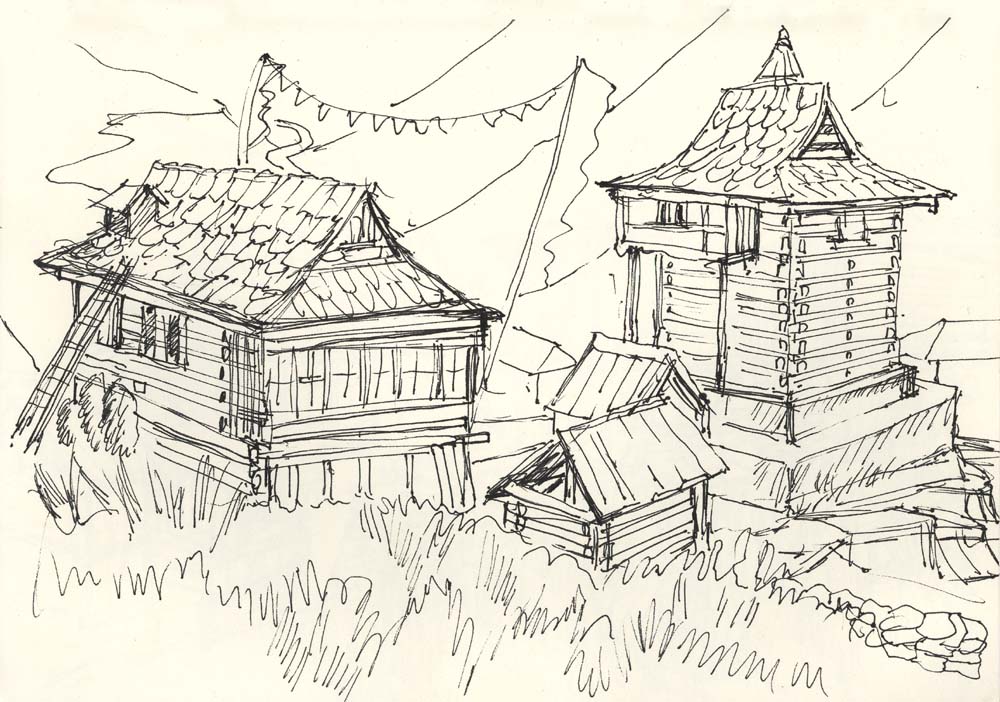
Chitkul is a small village that has retained a sense of innocence before the intrusion of modern society. A strange bunch of ugly concrete houses are coming up around the outskirts down the road where buses and jeeps park. Non-professional hotels and restaurants are being established waiting to exploit the tourist invasions but few tourists seem to find their way here. The hotel, owned by a family and in which I spent my first night, was noisy and run down. A large portion of it was used to house the members of the family, and their children screamed and were romping around. You could wash or take a bath at the front side where you also could have breakfast while looking at the mountain during sunrise.
The central parts of the village look nice with all their wooden houses. I moved to an older and more cosy hotel after the first night. It was a construction of stone and wood and had a fantastic living room with a window towards the valley and a large porch. And above all, it was less noisy, and the chef cooked delicious food. Even here, half of the rooms were taken by permanent residents. Tourists came and went sporadically while I was sitting alone in the living room philosophising before the natural world outside.
I’ll stay here for a while for some drawing and watercolour painting. I can feel a sense of uncertainty and existential abandonment. People come and go. What is evolution going to be like when everyone has mobile phones, water and electricity? The tourist business seems to be facing a crisis although the landscape here is fantastic.
While I am drawing, some of the village houses some kids just have to watch. I try to explain to them that they’re welcome back once the drawing is finished but their curiosity seems overwhelming. I show them my half-finished drawings of houses which they recognise with delight. Now their appetite for more is aroused to the brim and my appeals are to no avail so I close my sketch pad. They look around with furtive glances before running off to play elsewhere. I then reopen the pad after a careful look around I continue my drawing.
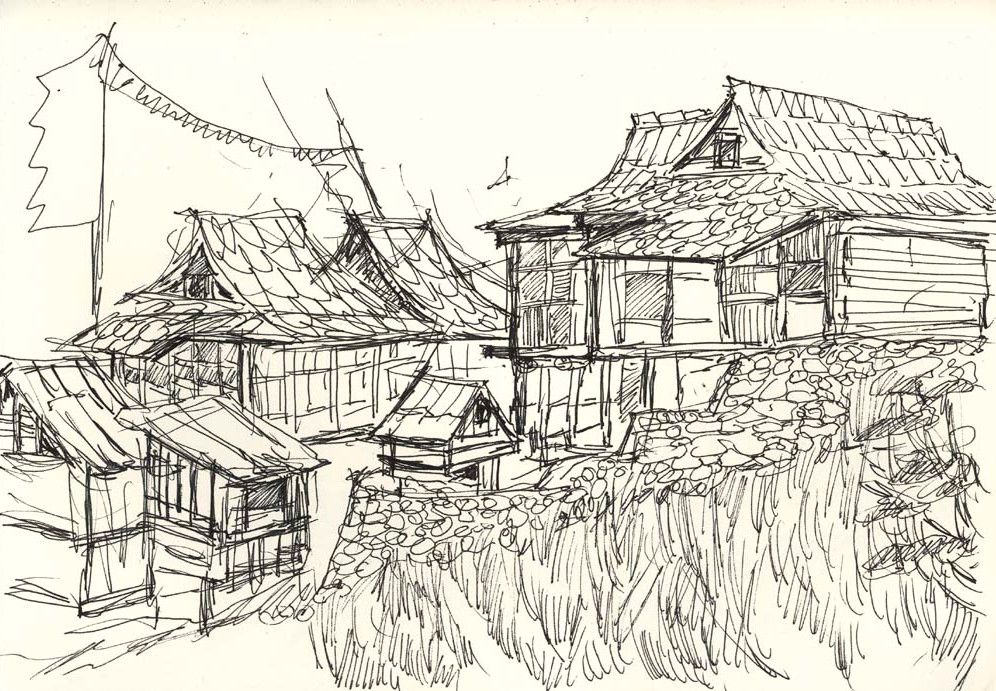
Upper level dignitaries together with some civil servants are inspecting the latest canal construction that runs through the village. The dam up at the stream has not been opened yet and there’s very little water in the canal. In the old days the water served small mills that were made of stone and wood. The grain was poured directly into a funnel placed on the roof and the flour was then collected one floor below the millstones, which were powered by a horizontally positioned paddle wheel under the house. The water was then guided by a steep wooden groove to provide a good slope. These mills have been abandoned for ages and the winding village road with steps of rock has been replaced with a smooth concrete pavement for motor vehicles.
The oldest barns were made of wooden beams and had a wooden or a stone roof although corrugated tin prevailed. The traditional building material of wood and stone have been substituted for concrete and raw galvanised tin that is going to corrode over time in rain, acid and temperature changes.

It’s nice to be sitting inside the glassed living room with comfortable furniture and looking out towards the mountains, the deep forests and the dramatic flight of the clouds over the mountain crests and hearing the hiss of the rapids in the background. A tiny brush of air makes the prayer flags beat while the sun lights up the green slopes and people outside chatter.
Whatever will come in my way is going to wake me up, whatever comes I will have to absorb; there is no moment better than this one, this moment of clarity.
The woman who touched shoulder at the departure this morning was hoping that we would see each other again. How do I interpret that? Transparency, no anticipation, no illusions. Just presence here and now.
Kant
The thing-in-itself, is it really beyond our experience and independent of the subject? Knowledge independent from outer impressions means knowledge dependent upon perception. What is cause and effect? Time and space? Our glasses tint the world, forming our categories of understanding. Does rock appreciate the thing-in-itself? Does rock experience time and space, does it apply categories of understanding, and does it accumulate experience or independent knowledge? The thing-in-itself is beyond our capabilities to perceive, beyond our horizon. Science has refined instruments at its disposal but the thing-in-itself lies still beyond the horizon. The Copernican revolution was all about human knowledge, that everything will be subordinated to man’s scientific skills, which are valuable skills and include logical propositions that are contradictory – the beginning of time – the infinity of time; knowledge that is independent of observation of the outer world.
There is never any certainty about things-in-themselves. Within the fine arts there is Kaspar David Friedrich who was both an Idealist and a Realist at the same time and tried to work with visual representation. Kant would not accept any visual representation of the thing-in-itself.
Experimental science is gaining terrain. Research is moving out . from the departments; the Empirical Science reigns, is refined and improved. Is there a free will? This is also beyond our horizon. To feel free has nothing to do with free will. We are affected by outer objects that raise moral questions. Is God the thing-in-itself? We don’t know whether or not God exists; it’s an idea about the absolute and nothing we have observed. There are guiding ideas about existence and we can have knowledge about something but none about the thing-in-itself. We may know any things about ourselves and progress in science, and so on.
All depends on my existence; if I do not exist, then then everything is withdrawn from my horizon. About non-existence I can say nothing; as I’ve said, it does not exist for me. Can I be certain that the thing-in-itself exists even when my consciousness doesn’t? It is a bit like the hen and the egg.
Let’s stick to Being. My heart is pumping, my thoughts appear and my consciousness receives. Being is there, resting in Being, existence.
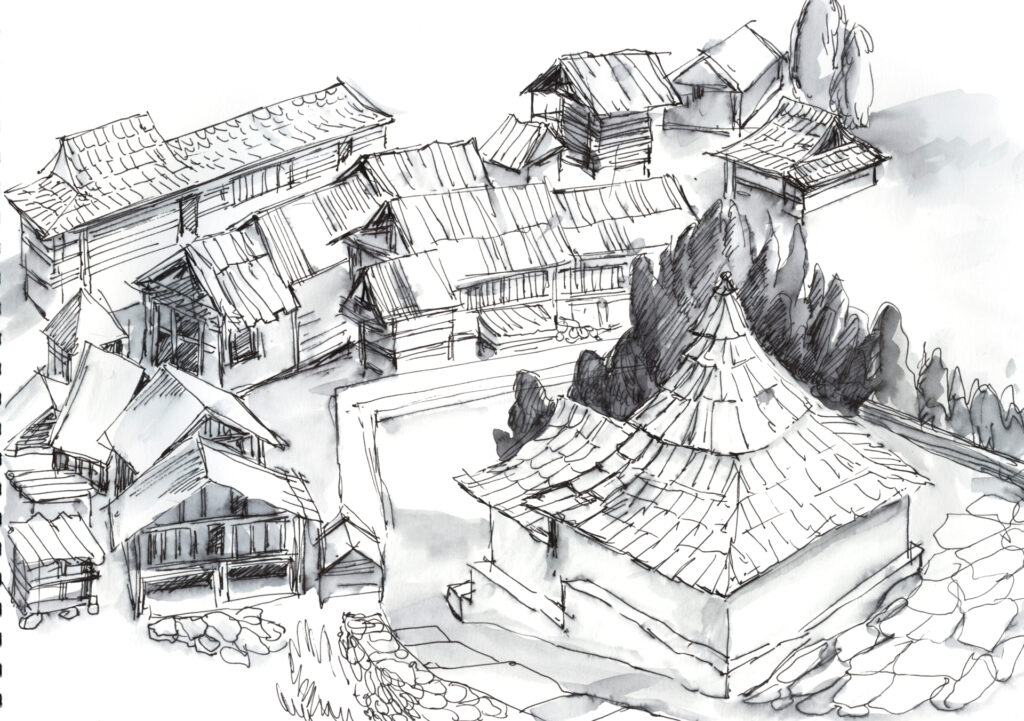
Construction work in the village is done using the cheapest available building material. Stone for a roof is substituted for tin, wooden beams for concrete and thus the architecture is not being preserved. Building material and architecture relate to one another but there are no restrictions related to house design, no construction legislation, no construction permits. The owner of the property is free to do whatever he wants, impede a neighbour’s view or obstructing the paths to adjacent houses. Houses stand half-finished due to lack of funding; extensions are left uncompleted and ugly. The unwritten laws come with religion, the temple, traditions and celebrations.
In the old days the streams used to run into the mills. They are very small and would still work, however the water supply is shut off, the wooden trenches are cracking up from dehydration leaving the houses standing like museum items. Here is no ethnologist, no antiquarian, no awareness of building traditions, but the skills of reviewing, documentation, renovation and preservation are in need here.
I’m thinking about her, her laughter, her smile, her young body with ripe breast and smooth skin. I want to feel her caresses, kisses, the small talk about anything, feel the bones in her body, the heart, everything that is human, the union of two bodies. Although I am sixty I still feel inexperienced. I yearn for the poetry of life, romance, currents of emotion from touch and union. Her young feelings are so fresh and multifarious they pass me by like a dream. What is real in this world?
I want know another human being in every bodily part; I want to penetrate the mind, the world of ideas, experiencing through another human being every little detail, laughing and smiling for the same reasons, sensing one another’s hands, nature, physically experiencing each other’s inside by penetration and ecstasy, union of the lover’s senses and bodies.
What do I want, I have no illusions, no expectations nor hope, only yearning remains. Here is the best of all times, now is the diversity of living, being close to the now, time; the immediate experience of time and space.
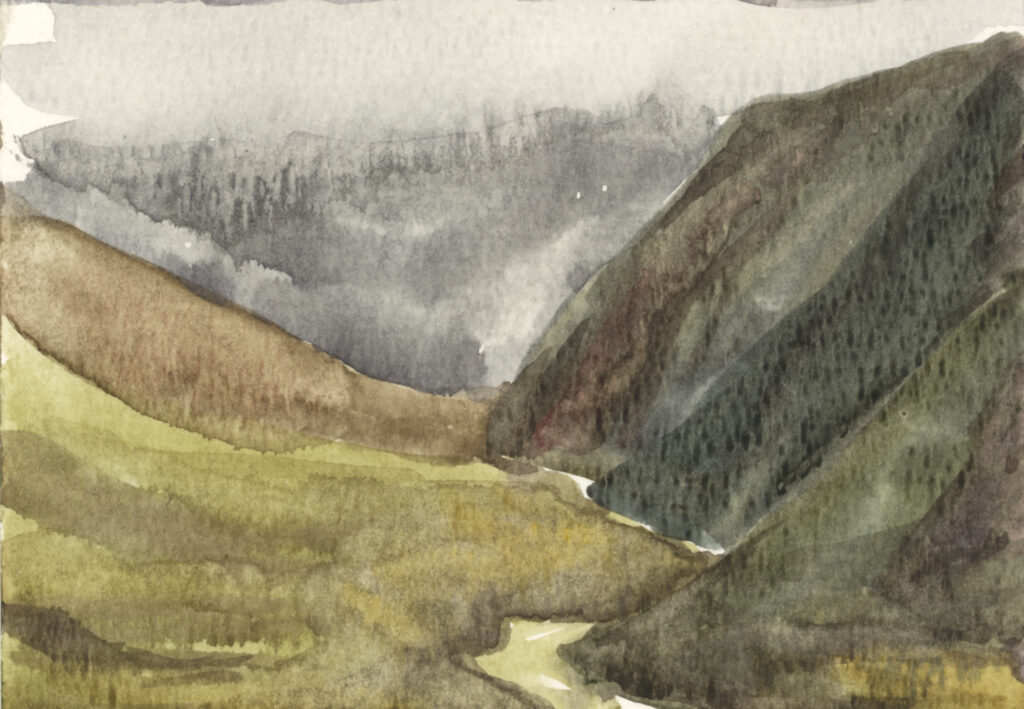
Morning over the mountains, the eastern slopes are set in a faint backlight with fields that are yellow green from the rye crop. Villagers carrying hoes and sickles move into the valley to their work. The rapids roar faintly in the background, or perhaps it’s the wind.
With a view like this view one could live for a long time. What more could one ask for, other than good prospects into the distance where imagination can find its hotbed. All seems revealed, the beauty of nature, stillness and flow, the movements of water and the movements of the mountain; everything is set in constant motion. Our days are counted, yet the heart keeps beating. I an looking intensely at the colours, the shades, and hear every whisper that is coming from the mountains.
A buch of sheep is being herded outside below the terrace; it is a cacophony of bloating. The kids are just a few months old, some even a few weeks and they stumble and fall while trying to follow the ewes. The herd is carrying a small one in a harness on his back, perhaps it’s injured. The wool is nice and thick before the coming winter cold. A donkey starts to neigh. They always sound like they are in agony somehow. They are suffering greatly from being ruthlessly used as beasts of burden.
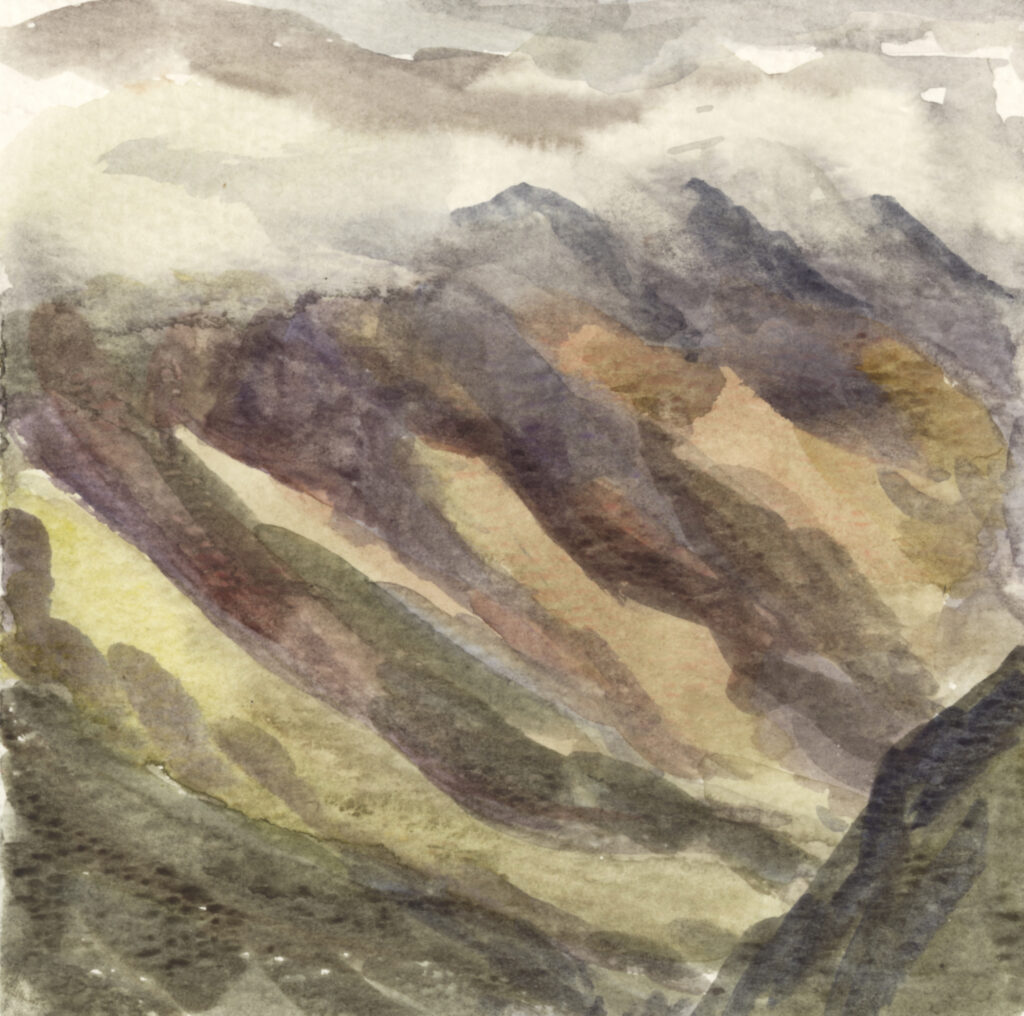
I’m painting the view and people want to watch. I have to restrain myself from becoming annoyed about it, I have to let go of being concerned. There is an unbelievable curiosity from the people nearby to see what is coming forth on the water colour pad and the disappointment great when denied access to see the result. Is the artist supposed to be some sort of a performing magician? A writer is left alone while he is working and nobody is demanding to review what is written there until the work is finished. But people think they can interpret and judge the work of an artist long before the painting is done, before it is put to the side. We think we are able to see with our eyes; however seeing eyes don’t see, it is the mind that sees.
Descartes
I think, therefore I am. It is my sensory impressions that I doubt and question. I doubt, therefore I am. I am, I exist and I am aware of the fact that I am, but what am I, who? I am aware, therefore I am? Thinking means being doubtful, affirming, perceiving, experiencing pain or joy, and so on.
I exist in relation to self; I am the one that is thinking. How do I understand the rest of the world? Am I aware of it? The awareness of self is an axiom within the Buddhist faith!
Is a thought a material process? The pragmatist will say so but dualism separates mind from matter, that is, there is a metaphysical basis and there is also a rational science.
However, nobody seems to believe in dualism anymore. Spinoza was critical about it.
Is mind independent of the body? Will the soul survive the body? If it is the case that everything is deriving from bodily substances, then Descartes philosophy I dead. Free will, however, was regarded as an illusion by both Spinoza and Descartes.
The soul, according to Descartes, is not bound by matter. Physiological examination of the brain cannot explain experience, feelings, perceptions, and so on. Disembodied thoughts, on the other hand, are difficult comprehend, and from a psychological viewpoint the maxim of I think, therefore I am seems more feasible.
Mind separated from the body. Thus Kant’s thing-in-itself could be understood. But Kant didn’t trust Descartes although he trusted the subject and everything was coloured by the subject.
Resting in the body, start from the body, life is in the body, the pusle of the heart, the workings of the brain and everything that is coming from the body’s sensory input. The mind may impede the input; I must be open before new thoughts, different impressions, sounds, views, people, conversations, the feelings and needs of others.
First I saw the Israeli woman who was attractive giving me all sorts of ideas about her. Then I didn’t notice her friend when she arrived, but she’s the one that’s interested in me which I didn’t realise until they had left for Chitkul. And then, when they leave Chitkul, it is her friend that I have fallen in love with. The brief but determined touch of my shoulder that she gave me while passing by behind my back saying she’s going to call me from Rishikesh. Everything seems elusive and illusory. However, I have still this gnawing thought, what if…?
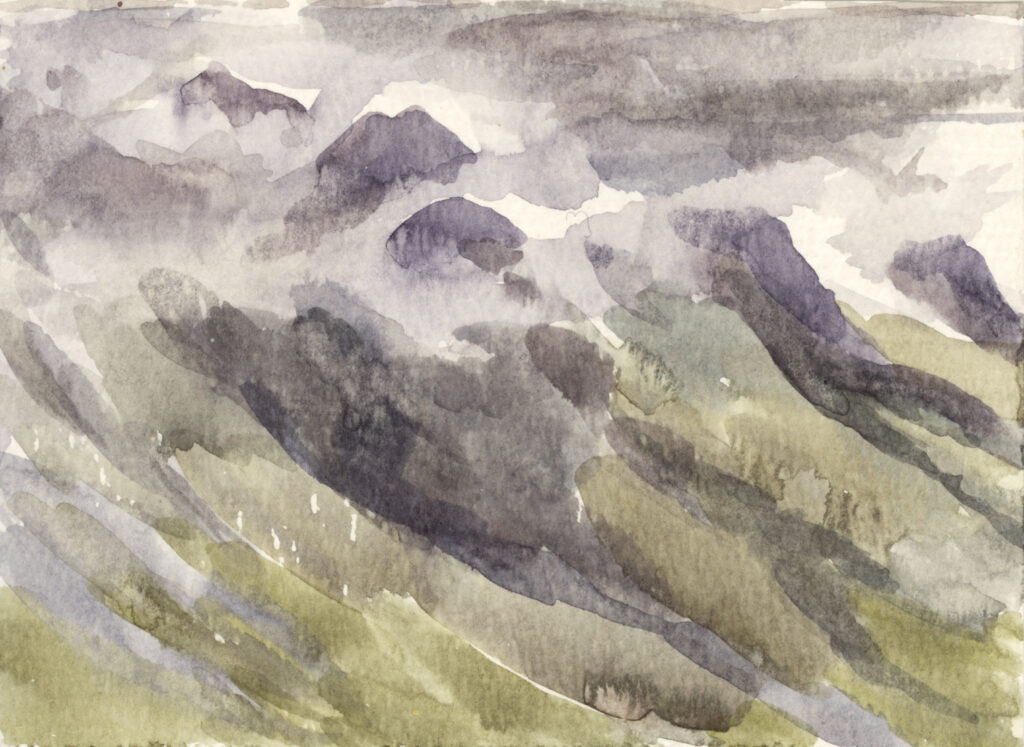
Kalpa certainly had a lot more to it and so did Chitkul. But we travel on, any journey must end somewhere and one must return back home, wherever home is supposed to be, or work, or sustenance. I could go on for days on end here in Chitkul with drawing, painting, exhibits, courses, expeditions, getting to know people, the rich, poor, intelligent, talented, and stupid people. The amiable midget who had a girl for best friend, the tailor in his shed, the woman in her Kinnaur hat with the green band, the children who go to school dressed in uniform. Traditions, the celebrations for the gods, music and dancing. The tourist with furtive glances on his way from one attraction to the next. A short stay here, and then off to new experiences. It’s all here and now; everything is going on inside me.
Night falls on Chitkul and new tourists have arrived. One stays at a guest house, having a stroll looking around assessing tourist attractions. That’s how it is with us tourists, although everything would really be worth visiting, but there is always something that is more enticing, something that will justify my being here, that give value for money, the natural scenery, human nature, culture…?
Have I been able to retain my common sense? Sweden, and life that’s going on there, seems so remote; it doesn’t really have to exist. I could stay here forever, to the end of my life at least. Of eternity we know nothing, and I least of all.
2nd of September
Two weeks left of my holiday. The journey back has started. I am going to cut my stay here by one day. I hope I will be able to take a long walk today and listen to the hiss of the rapids, watch the mountains and experience the fragrances of the earth. There is no particular place for me on the Earth: My home is here within, inside of me.

Shimla
3rd of September
I have arrived in Shimla after a twelve hours bus ride from Chitkul. The city is appallingly ugly and disorderly with a vulgar middleclass Indian tourism mostly visiting moderns shops, eating at fancy restaurants and strolling along The Mall with a view over the distant snowy mountains. You can take a sweeping look over all the colonial memorial buildings such as the church, the theatre, the club house, the post office, or the library. A bit further down the southern slope you’ll find the railway station for the Lilliput train that has become a world heritage monument.
The hotel room wasn’t the best I’ve seen and I’ll be staying here for a night or two. My back problems have returned and I feel lonely. There’s internet connectivity again and some e-mails to respond to.
My mind is still in Chitkul. The ride from there had an intense clarity to it and I felt completely lucid. A group of people wearing pretty hats and tools carrying stepped on the bus right after departure. A skinny sheep also got a seat along with a kid that a young man was carrying inside his bag. Sometimes it peered out of the bag and bloated. Women and men were on their way to work together on the fields. One of the women seated herself confidently next to me and in the tight space I could feel that her knees were very thin. This early in the morning, the fields shone in different colours. They were surrounded with stone hedges that were made of the white granite they also used for house construction. I never got an answer to why pink and yellow flowers were cultivated on these fields. They stepped off the bus in a merry mood and seemed to be looking forward to the work that lay ahead while they carried their lunch in tiny bundles along with milk for their tea. I was there by nature, they were there by nature, and happy about working together in nature. We’re made for this, every part of us, our eyesight, our hearing, and our olfaction. Everything turned infinitely large, the streams down the valley and the bare pointed peaks above that were circumscribed by clouds slowly passing by. I feel the freshness in the air and the happiness of being.
How different is it then here in Shimla where I’d rather go hide myself from the rest of humankind.
There is a small library in Shimla that contains very few books and inside of which most people only read newspapers, those that cost about 5p in the street but few can afford to buy.
The hotel balcony is a fortress with bars around it; perhaps there’s a problem with burglars or mischievous monkeys. I look into the mirror and I see and old man in need of exercising, my back is troubling me and I must regain flexibility. I’m looking at the lit up Shimla by night with all its intrusive noise; the traffic is still horrible. Do I see mosquitos here, do I need to use the mosquito repellent? I have never done that before during this journey.
4th of September
I could locate the new bus station at last once the city structure had become a bit more familiar. First of all, you need to have seven Rupees ready to pay the lift down to the road where the buses go. They go to the old bus station for local traffic only. I have time for a cup of tea before a bus gets me to the new bus station for long distance lines. When I have arrived there I had a Koli, a carrier, bring my knapsack to the right bus and tied it firmly onto the roof. I realise that there must be a ticket office somewhere for me to reserve a seat. It’s a modern station that occupies two floors with spacious waiting halls and electronic displays for the gates. The computerised system makes the purchase simple, and there I have reserved a seat. It is a bus network cooperative and strictly regulated in Himachal Pradesh. Anyone who steps on during the ride receives a ticket printed from a small calculator. The ticket inspector will check the tickets at some point and browse the calculator memory and look at tickets. It’s difficult to make any extra profit from the occasional traveller.
The bus meandered down the mountain on endless serpentine roads passing cities, small towns with schools, a bank, and farms distributed over the terrace landscape. The air turned delightfully warm with the lower altitude and the greenery had become intense after the rain season. When I arrived in Dehradun I lavished on a taxi drive to Mussoorie and Devdar Woods Guest House. It was a joy to be back in familiar surroundings with all its memories again. Calm and relaxing with snug conditions like breakfast, lunch, dinner, and a cup of tea whenever I want. The circle is complete.
The solitary bird outside in the tree is tweeting with such an exact interval between the one and the next tweet-tweet that it sounds eerie.
I need to reset, too much sex on my mind. I’m thinking about her all the time and it’s nothing but illusion. She is not going to call me, she is seeing other guys in Rishikesh. I don’t have any expectations but she would make a nice company…
I need someone I can talk to, need to communicate, need presence, both physical and mental, to touch and be touched.

Mussoorie
5th of September
I went up early for a morning walk. I saw Sima who gave me her sweet smile. She remembered my name and thanked me for the water colour I gave her last time I visited. Their hotel was fully occupied.
The sun lit up the mountains and in the clear air I could see all the way to Dehradun. Monkeys jumped between the trees and a herd of goats were shepherded by an elderly man with his son. Two juvenile dogs tried to help. Small goat kids whined wearily beside the female on the minimal shelves from which they tried to reach fresh leaves from the trees.
I’m the only guest at Devdar. The birds tweet and I can distinguish at least five different calls. The deodar tree in all its glory spread its branches covered with fern. It feels like I’m always going to stay here listening to the birds, the barking of dogs, and human chores.
It’s close to just ten days left on my holiday. I intend to pass time by studying Hindi, learning how to read and write, receiving good advice on which books to buy and read as a modest and inspiring start for beginners.
Hot as always. On the bus down from Shimla a girl, that could have been picked from a fashion magazine, stepped on. She had tight jeans that followed her curves, large eyes, pouting lips, beautiful facial features, a bit of a belly perhaps, very young, under twenty. She was that ambivalent transfer state between girl and woman, unabashed, self-aware, stylish with something that was uncontrollable and fatalistic about her. She stepped off after thirty minutes by a larger village without any handbag or clothing other than a thin blouse, jeans and that sexy bottom. The fascination, the desire from such a woman can drive a man crazy but I yearn for a mature woman with brains and presence. I have never really understood relations with a women who could be your daughter. The initial attraction will give way for reason and what is realistic. I wouldn’t be able to stand that persona, or could I manage this kind of self-awareness?
I am nothing more than my pulsating body, and from it my thoughts arise. The mountains are my intimacy, and outside there is rain and fog. How do they manage to get their clothes dry in this humid air? The monkeys are walking on top of the wall, their young skipping about; the chill is intrusive and I am yearning for warmer weather. I’m not getting anything done in terms of art, painting or drawing. My Hindi study incites me to read and write in Hindi and makes me increase my vocabulary. My teacher gives me compliments for my spoken Hindi. It is remarkable to be back at the school in which my mother used to teach sixty years ago when I was born. I remember that she spent some off duty time during the winter break down on the plain-land trying to teach us the Devanagari alphabet so we could read and write Hindi. Some of it stuck in our heads which otherwise were occupied with adventures among the bungalows, playing with the Indian children or climbing in the bamboo grove.
I exist in this body, I’m getting nowhere, I’m hearing the nocturnal bird, I’m sensing my heart beating, women come and go in my mind, none is real. The feeling of fatigue in my body, soon I will sleep and the morning will come.
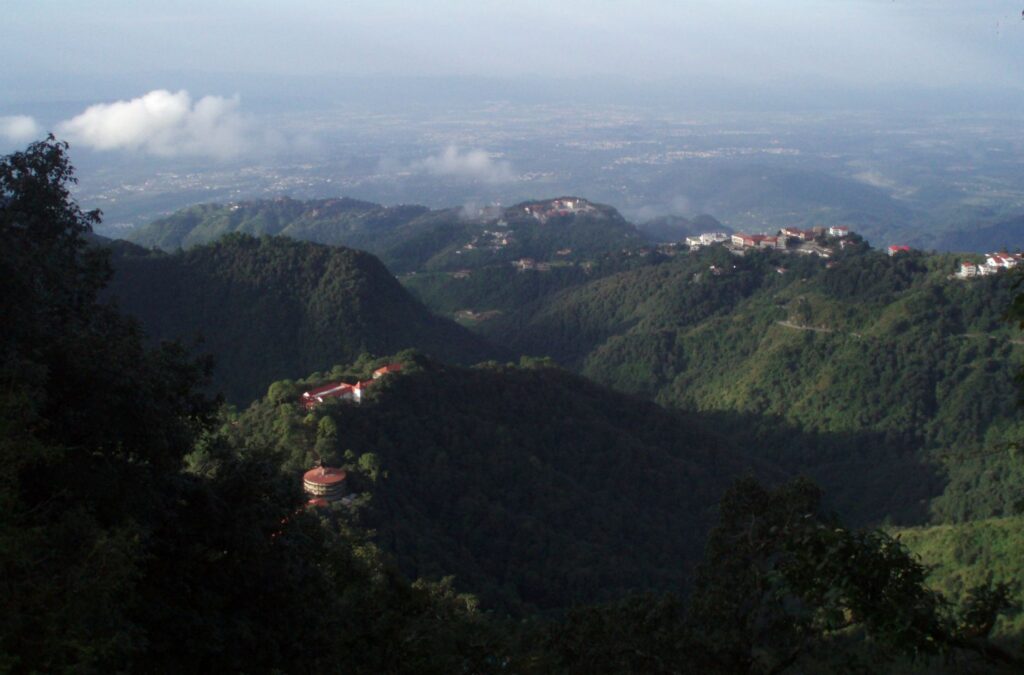
Coffee at a modern coffee house near the old Library, nowadays called Gandhi Chowk. I can see parts of Mussoorie all the way down to Dehradun, Rishikesh and Haridwar. Dehradun has been expanding greatly since it became the capital of the Uttarakhand State. No high rise buildings yet, but it won’t take long. The central parts of the city is a conglomeration of streets that are horribly trafficked. The density of the city is somewhat decreasing upwards the Rajput Road which serves as the main highway towards the mountains and lined with bungalows, boarding schools and government buildings that spread out on vast areas. The view from here is like a dream, the clouds tower above the mountains that are turning blue with the distance forming a low faint undulation against the plains where the winding river can be seen.
I found a small cottage above Devdar that had a kitchen, bedroom and a view from a private porch. Here I could stay until I die. I was a bit eerie in the middle of last night that I felt everything was wrong with life. Now, in my waking state, I realise that the communion with the Earth and humankind, a chat with the hotel staff, a dog is following me, we sit together gazing at a part of the cosmos, the villages in the distance with terrace cultivation, people living intimately with nature, the animals and vegetation. There’s a great happiness in living in this vast infinite entity that is I, the world and those that are closest to me.
I am surrounded by clouds; I exist in the midst of white mist and the sound of rain on the tin roof gives me goose bumps of pleasure.
Why then this sense of being abandoned? Here I am with all of my body to get acquainted with, to live with. It is giving me a pleasant sense of presence. We cannot be anything apart from the body, this pulsating life that is present in space. My temper is my inne pulse and I must be intimate with it and nourish the body which is nourishing the brain which is nourished by inner and outer impressions. We are what we are in every moment. The best time of all is here and now. My experience of communion puts my components together to form a unity but loneliness splits everything into atoms, as opposed to being alone which is a whole in community. My infatuations are all but memories and out there the world is waiting.

Through the door a wet fog sweeps in, the tea smells like cow dung but the taste is good. Is it something in the air?
My home is here, so easy to forget. Sexuality, the protruding genitals and the desire for penetration, puts me outside myself experiencing a woman’s inner world physically, like the spiritual familiarity after a lifelong acquaintance. I always return to my own quarters, the outlook from my windows where I feel my legs, my spine, the work my hands are doing and the movement of my lungs.
Here the world does not intrude, only the play of nature, sounds, small movements, the ever shifting light. Somewhere far away I have my work, my money, my pension, my insurance, my stuff.
I’m walking through the foggy forest, trying to paint it. A painting demands exercise, experience, and experiment. The mountains of Spiti never came out like I had expected but nothing can be foreseen; restrain yourself or consider it done. In Chitkul I pained one picture six times, all of them in different weather and light conditions. We’ll never be finished with reality.
I feel that there is not much going on inside me; everything doesn’t come from me. The interactive Being, the source of which is my life in accord with other lives is the context in which everything is happening.
It’s difficult to communicate, to come close. From a distance I realise that some sense of unity exists with mutual thoughts and experiences. An American at the dinner table is difficult to comprehend, easy to talk to, but emotionally unintelligible and strange.
It is a good thing that I have started my exercises in Hindi. It’s going to be very useful for me.
I am yearning for something, but why? Here is everything, really, that could meet my needs. There are delightful women, intelligent and sophisticated. Nature is beautiful, and there’s TV with lots of movies, there are all kinds of books and music that can be purchased and listened to. What’s wrong with me? Is it some kind of inner adaption, to accept conditions?
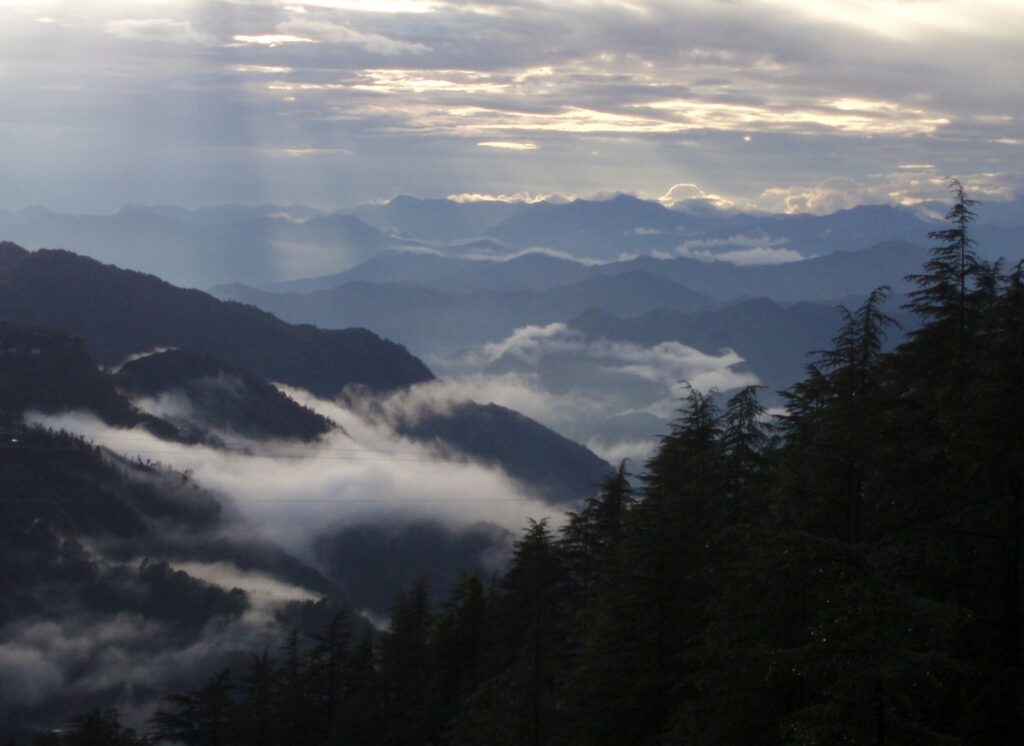
I wake up to a beautiful day taking a walk around the mountain and the temperature is pleasant. Everything is as it should in the post monsoon period with clouds climbing up over the mountain ridges that fade off into the distance playing hide and seek. Life is within and without us.
Roads go up and roads go down. Whenever you go downhill you’ll have to reconcile with going uphill later, until the last downhill walk is done. I like walking uphill for that means the walk back is going to be easier.
I’m having a magical evening outside the small cottage with the full moon over the mountains and the sound of nocturnal birds calling. Two of them call together and after a while they sound in unison and then coming apart and then again approaching each other.
This is my last day in Mussoorie. The mist is enclosing the house and there are moments of clear sight towards the mountains. The air is saturated with humidity that is dissolving my water colours, sugar and salt become transparent, mould starts growing on the walls, moss grows everywhere and there is a smell of moist soil conifer from the forest. Everything is so close up, present. The bluish tinted valleys towards the Himalayas with green terrace cultivation have streaks of dark forest in the shadow of clouds that are lit by the sun. The fog is moving slowly, hiding and revealing.
I feel peaceful and still, do not need more from life; why do we pursue more, experiences, ecstasy, fulfilment of all dreams… There is nothing except this being. Birds hunt for food and will do whatever it takes to fill its belly, spring will come and it will mate, lay eggs and have their young. Man worries about supplies, survival and the future. I could be sitting here until I die but I must be on the move looking for a job to obtain food, look for company, speak, feel, kiss, hug and copulate.
What is important in life is all and nothing! Speak Hindi, converse in English, listen to the news, comprehend the world economy, conflicts in Afghanistan, and kidnappings in Somalia, terrorist threats, or the dismantling of companies. I can live without all that. But I am a part of humankind and contribute with my understanding and feeling, communicating from my little corner of the world, seeing what I see even through the eyes of others as far as I can interpret it. Still, all of it exists within me, is in me, both that which I believe is outside of me and that which I experience in this moment. Is there a section of me that perceives that which is outside? My total being in the now is part of my world view. I finish my work, eat supper, close the door, and turn out the light and sleep.
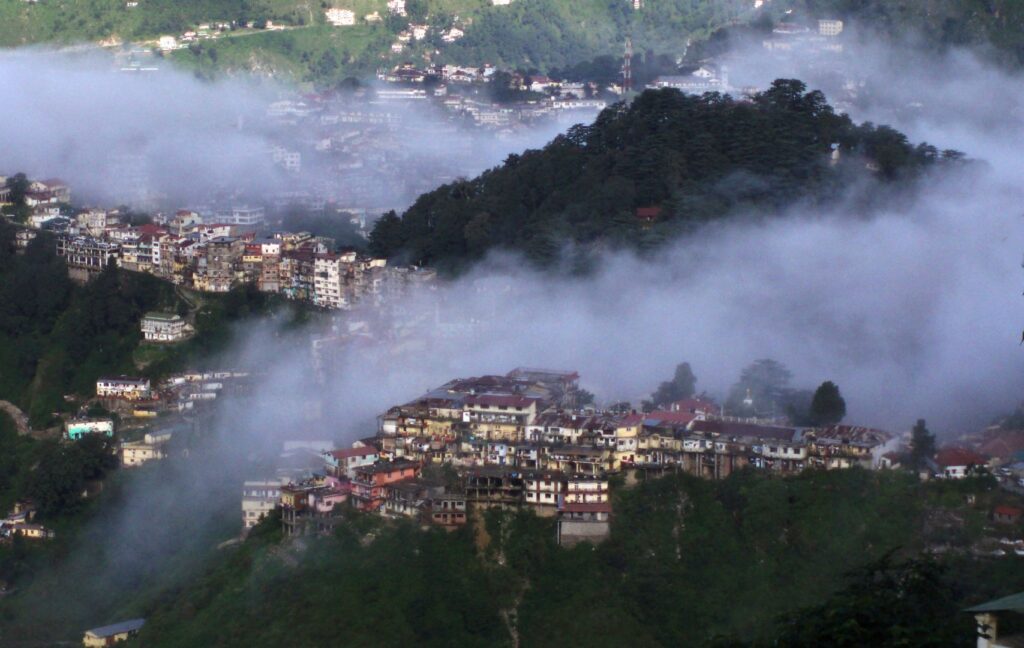
I am going to stay in Mussoorie when I get old. I am drawing the old colonial houses from the top of a hill in Mullingar like I have done so many times before. I’ve had time for drawing, I have learnt how to read and write in Hindi but there’s plenty left before I will master it.
Getting down from the mountain with all its rest points, steams, advertising boards and the ever-changing views is pure nostalgia. I arrived into the chaotic traffic of Dehradun and caught the train in time.
The time for tea is over and the train is leisurely making its way through the tall eucalyptus trees of the Doon valley. I attempt to read a newspaper in Hindi but I’m slow. For this trip you’ll have to pay extra for a comfortable seat, food and service. First on the menu samosas are served, then namkeen and tea. For dinner a hot spiced soup is served with bread and butter.
A two months holiday in India feels like an eternity. Each moment is an eternity within and life is a blink of an eye.
The railway station in Saharanpur is a miracle of orderliness, no beggars, no stray dogs or illegitimate salesmen. We halt here for twenty minutes.
The man who is sitting next to me is engaged in some kind of private prayer ceremony. He repeats a mantra while fingering his prayer beads. Some people here have indeed their earphones on when listening to music from their mobiles. Some talk loudly, just like they do in Sweden, about what they had for lunch, when they are expected to arrive and trying to appease their worrying loved ones. The train is delayed and keeps stopping at each insignificant station. The man beside me seems to be done with the prayer, clears his throat but doesn’t appear to have obtained any inner peace like one would have expected and is stirring nervously.
I’m already yearning for Chitkul, Kinnaur and Spiti. The noble guesthouse owner in Kibber whose son was sent to the monastery to become a monk is a person of great honour among Buddhist Tibetans. He was a very pious man who cared greatly for everybody around him. I yearn for the staggering beauty and dramaturgy of the landscape.
The locomotive is broken and we’re waiting for a replacement. We are forty minutes late. In the old days such incidents were always to be taken into account, but the Indians apparently trust this train to be on time. People start calling on their mobiles announcing they’re going to be late; some are listen to music or watching movies on their iPhones. All of that stimulus, couldn’t you meditate instead; your inner life is a joy. I have to sit with my jacket on because the cold from the air conditioner has become a nuisance.
The train is at last set in motion, we’re moving, and we are reassured by motion confirming we are on our way.
What has happened during these past two months? The future will show. I find myself in a split mode. Can the world be healed? It needs to be seen in the condition it is. My life in the world, on the Earth. There are the poor, suffering, the sick ones, and the children who cry from loneliness and abandonment, that which was my experience from the outset. I’m coming back to myself; here is my home, nowhere else.
The train has halted again and it’s going to be late before we arrive.
15th of September
The light is putting on a show through the hotel room window curtains. They are never opened to preserve the cool temperature and the blinds are always shut. The AC unit is heavy and is protruding from the wall having an alarming slant. There doesn’t seem to be any console to keeps it up there. The sound of twitter from birds, roaring traffic and people working on the street find their way into the room. In the middle of Delhi animal life is rich with all kinds of birds, squirrels, ants and other insects that thrive in the heat.
I’m sitting once again in one of those air conditioned coffee shops by Connaught Place with a cup of coffee so expensive that its price could have supported a poor family for several days. This is of course gnawing at my conscience. The rain period is not yet over. Lightning is flashing over the quickly darkened sky outside. Then comes the deafening thunder and the rain is pouring down forming large pools like a quagmire of mud that flows the pavements under the posh arcades where the poor beggars sit.
I shop notebooks, sandalwood soap and lots of namkeen at the bazar. When I am about to buy incense at one stand outside a temple a quarrel starts between the shop owner and a man who had been abusing the water tap behind the shop. It turns into a fight and a large crowd is gathering. When the combatants at last are being separated from each other the fight continues between the other people who had interfered in the original conflict. I’m prudently raising a finger pointing at my incense and I can finally pay.
The next day I am whizzing forth at ten thousand metres of altitude towards something that is called my home; however I never liked coming home from India. I dream myself away to other places. I am yearning for Italy, good wine, pasta and espresso, Greek feta cheese or Portuguese fish barbeque and shellfish. But there is also work to do with art, exhibitions, music and film, and doing excursions into the archipelago and nature. Until the next trip.
Text, drawings, water colors & photos
Davey Hammarsten
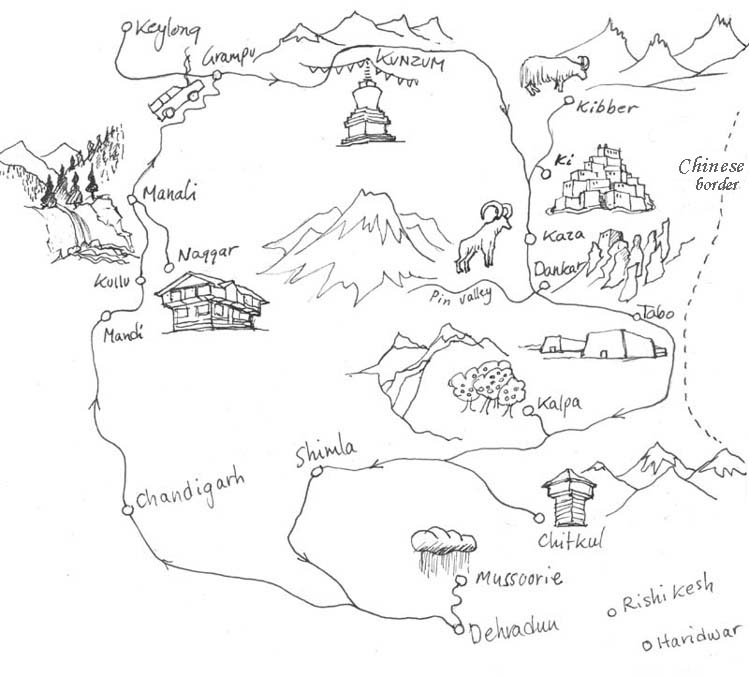

Chakra (Sanskrit) one chakra many chakras, means wheel. A concept within Hinduism and to some extent certain related Asian cultures; has also been adopted by the New Age movement. Chakra, also called ‘wheel of life’, is understood as a series of hubs where nadi is channelling the flow of prana, or life energy, cross each other. It is also here, in these chakras that the physical body is said to connect to the ethereal or astral body according to the chakra teachings.
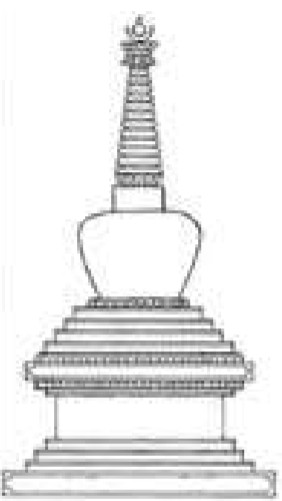
Chorten is a Tibetan Buddhist stupa that has several different symbolic meanings. Originally it was a grave containing relics from important llamas, but it represents the image of Buddha in abstract form as well. Its fundament is a lion’s throne and the square steps above represent Buddha’s legs in yoga position. The dome represents his torso, the square hamika his head where eyes usually are painted. The spire is the twisting of his hair called ushnishan, the canopy represents royalty, the moon, and the sun and the flame are symbols for enlightenment. In addition, the square fundament also represents earth, the semi-sphere dome represents water, the conical spire represents fire, the upper lotus canopy and the crescent moon represent air, and the sun with its illuminating flame is a symbol for space. You are always supposed to pass by a chorten on the left hand side. It is a symbol for the world mountain in Buddhist and Hindu cosmology.
Notes
- Cedrus Decodara (Himalayan Cedar, Deodar/Devdar) Building material much appreciated for its sustainability.
2) ”Chakkar” is wheel in hindi
3) ”Char dukan” means ”Four Shops”.
4) A bodhisatva has renounced his Buddha status and Nirvana in order to stay here and save humanity from Samsara.
5) Religious painting for meditation
6) I haven’t found anything that conveys this meaning in dictionaries of Tibetan Buddhist symbolism. They denote various offerings and spiritual exercises. 1. Prostrations. 2 Gifts, offerings. 3 Confessing nonvirtuous deeds. 4 The joy of good deeds from myself as well as from others. 5 Asking Buddha to teach me. 6 Asking Buddha to remain here in this world. 7 Commitment to meritorious deeds.
7) To circumambulate a temple or a monastery clockwise
8) The Kalachakra Initiation is generally given over 12 days. First, there are eight days of preparation rituals, during which the monks make the mandala. Then the students are initiated, after which they are allowed to see the completed sand mandala. The ceremony ends when the monks release the positive energy of the mandala into the everyday world through a final ritual.
Afterword
The diary entries from a journey in India 2011 have been edited and supplemented with factual information where needed. Drawings, watercolors and photographs are in the majority from the trip except the initial stay in Mussoorie where the watercolors were made in 2008 and drawings from Manali are from my stay there in 1987. My trips in the Himalayas so far has gone to the following places: 1980 to Ladakh and Nepal, 1987 to Manali, Daramshala , Dalhausie and Chamba, 2000 a short stay in Nepal, 2004 to Badrinath, 2008 to Nainital, Raniketh and Almora, 2010 to Sikkim, 2012 to Tibet and 2015 to Ladakh and Manali.
I would like to thank Evert Wängberg for help with the translation and all difficult philosophical expressions and concepts. All possible errors are completely on my behalf.
©Davey Hammarsten
Göteborg 2018
Svensk PDF version
http://davey.se/PDF/Chakra_pdf_bok_sv.pdf
English PDF version
http://davey.se/PDF/Chakra_pdf_book.pdf